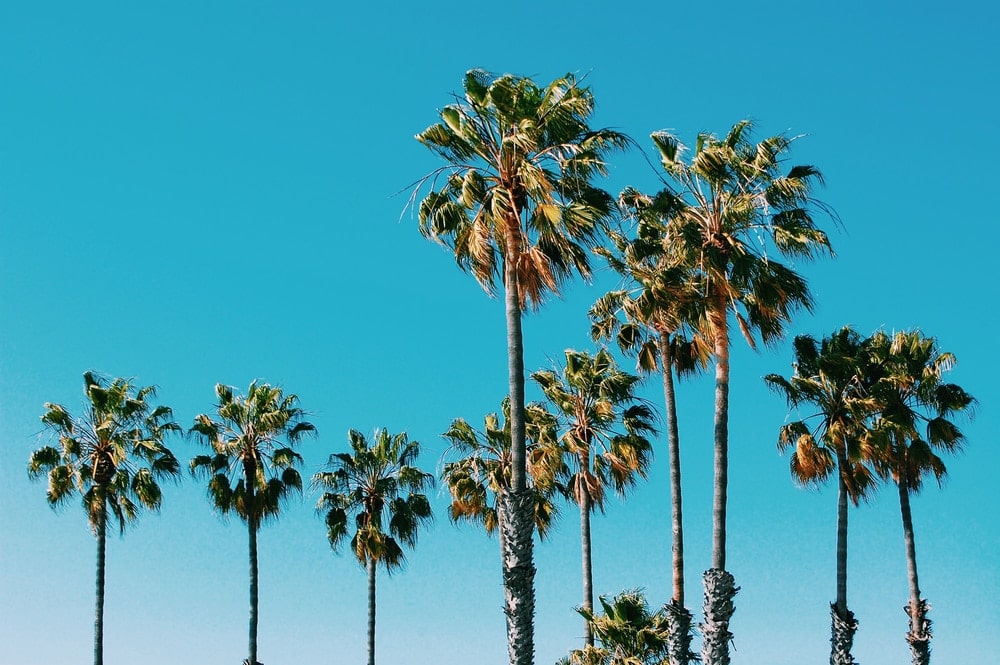
When you think of palm trees, you’re most likely thinking of coconuts and sand. This is because people most associate palm trees with warm, tropical places like island beaches.
Although most palm trees do grow best in warm, moist climates, they can also grow elsewhere. Most palm trees are incredibly adaptable and can survive in many conditions. Some trees can survive extreme salinity. Others can live in temperatures as low as 5 degrees Fahrenheit (-15 °C)
The point is, though, that there are thousands of different palm tree species and none of them are the same. They all have their unique characteristics, and they all look quite differently from one another. Some have that tall trunk with the broad leaves and coconuts that we all think of. Others lack trunks completely and look more like shrubs.
Chances are, you’ve seen a palm tree before and never even realized it was a palm tree. If you’ve ever been interested in these beautiful plants, keep reading to learn more.
What Are Palm Trees?
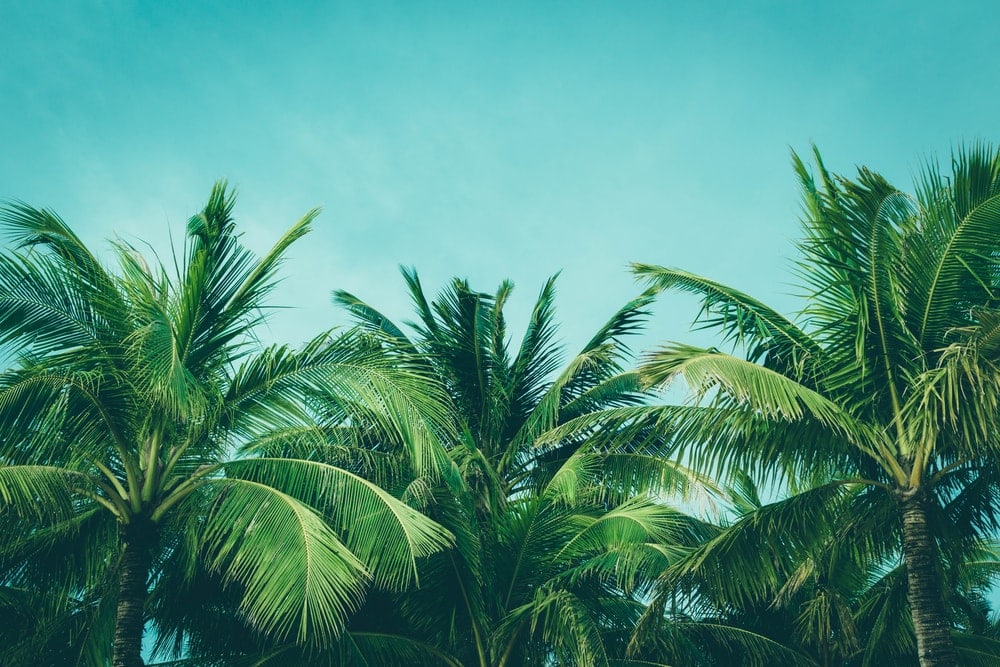
Palm trees are a kind of evergreen tree. When most people think of evergreen trees, they just think of fir trees, or pine tree-like trees. Really though, evergreens are just trees that keep their foliage the whole year round.
Palm trees are part of the family Arecaceae, and are defined by their branchless stems that showcase large, wavy leaves.
Trees classified as palm trees come in all shapes and sizes. Some of them are very small, with the smallest only reaching about 6 feet (1.8 meters) in height. Other palms can grow up to 100 feet (30 meters) tall.
Scientific Classification of Palm Trees
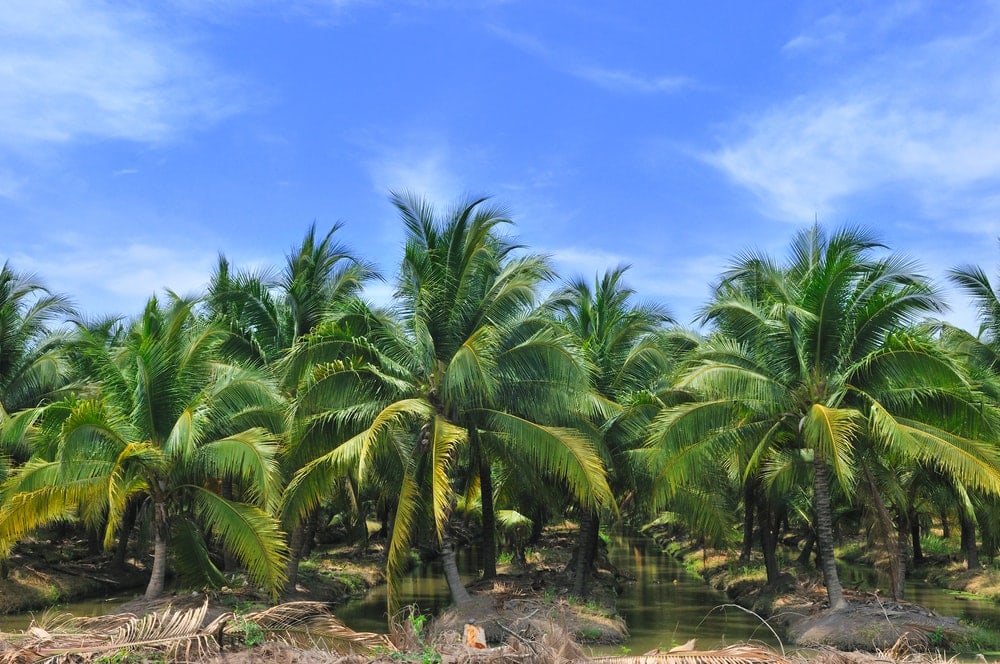
Taxonomy is the way that scientists classify organisms. This is an organized way to put organisms into groups based on their physical and physiological characteristics. Below is the taxonomy of palm trees from broadest group (kingdom) to most specific (species):
Kingdom: Plantae
Phylum: Magnoliophyta
Class: Liliopsida
Order: Arecales
Family: Arecaeae
Genus: Archontophoenix
Clade: Angiosperms, Commelinids, Monocots
Tribe: Areceae
Subfamily: Arecoideae
Number of Species: 2,600
Why Are Palm Trees So Popular?
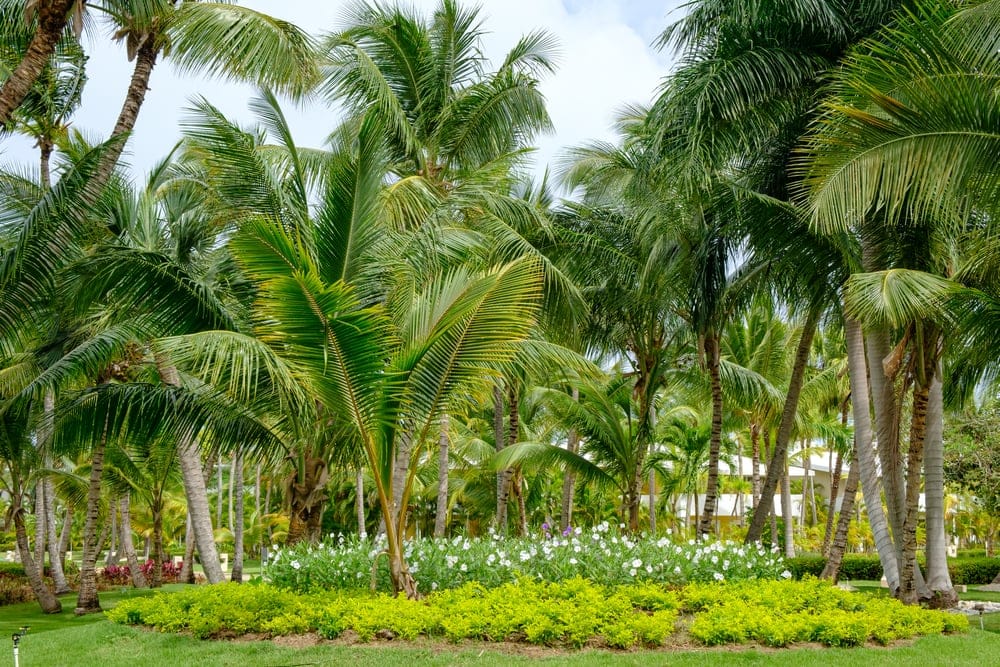
People love palm trees so much because of their ornamental appearance. Every palm tree is different and unique, and there are some truly interesting-looking palms out there. Palm trees are also used commercially for products like coconuts and dates.
How To Identify The Different Kinds of Palm Trees?

There are thousands of species of palm trees, so how do scientists classify them? Usually, they look at the shape of the leaves. This is the most basic way to separate palm trees because some will have feather-like leaves called pinnates, while others will have fan-like leaves called palmates.
They also use the trunks to distinguish different kinds of palms. Some trees have more interesting trunks than others, and some have no trunks at all. Some trunks will be very smooth, while others may be bumpy or ringed in bark. Some trunks may even be covered in husks or fiber. These make the trunks look hairy and spiky.
You May Also Like: Discover These 47 Types of Pine Trees to Differentiate Edible to Flammable with Photos, Facts, and more!
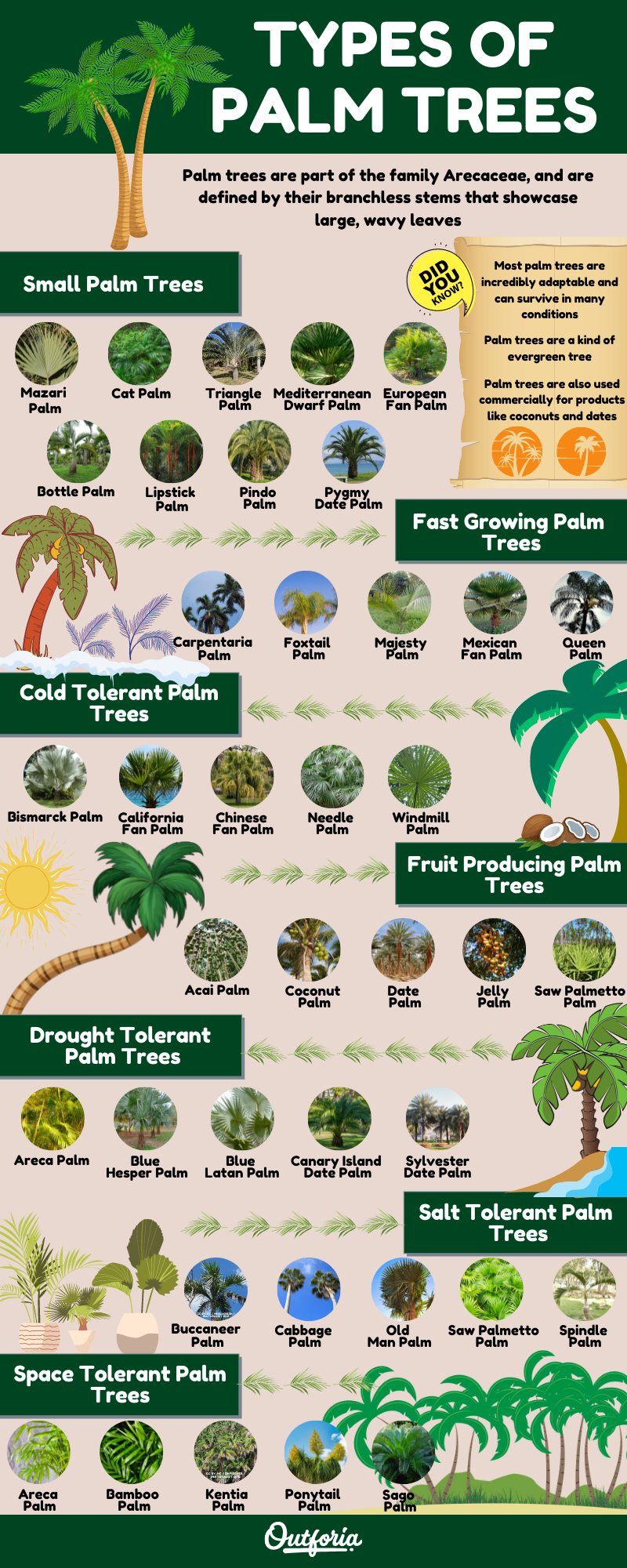
Share This Image On Your Site
<a href="https://outforia.com/types-of-palm-trees/"><img style="width:100%;" src="https://outforia.com/wp-content/uploads/2022/01/Types-of-Palm-Trees-infographics-01052022.png"></a><br>Types of palm trees Infographic by <a href="https://outforia.com">Outforia</a>39 Different Types of Palm Trees
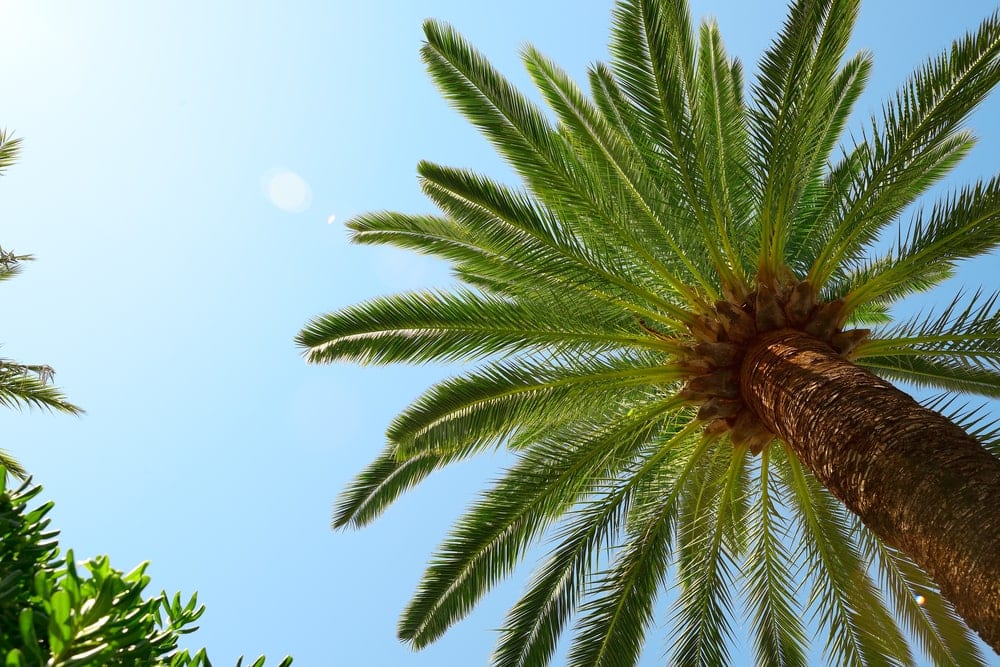
Palm trees are not all the same. In fact, there are over 2,500 kinds of palm trees, and 202 different genera around the world. Most of these species are found in tropical, subtropical, and warm climates.
Palm trees usually can’t survive in colder climates, this is why the majority of the species are found in warm regions. However, there are some palm trees that can survive in temperatures as low as 10 degrees Fahrenheit (-12.22 degrees Celsius).
These cold temperature trees differ from tropical palms in their growth rate and their overall height.
Because there are thousands of different palm trees, it makes sense that there would be numerous variations. Some trees only have one trunk while others have several trunks. Some have a growing habit that more resembles a vine. Leaves are never the same; different trees will have leaves of different shapes and colors.
Because they all look so different in their appearance, it’s easiest for scientists to classify them based on their physical attributes.
Because there are thousands of different trees, we need a way to classify them. Scientists have grouped them into a few major categories. They are separated based on the physical features of their trunk, leaf structure, growth rate, size, and cold tolerance.
Palm trees will also differ in their ability to withstand drought and salt. They are also separated by how they produce flowers or fruit. However, none of these attributes are used to specifically classify the type of tree.
Today, we will be breaking palm trees down into seven categories. Within those categories, we will explore some of the most common types of palm trees around the world.
Breaking Palm Tree Types Into 7 Categories
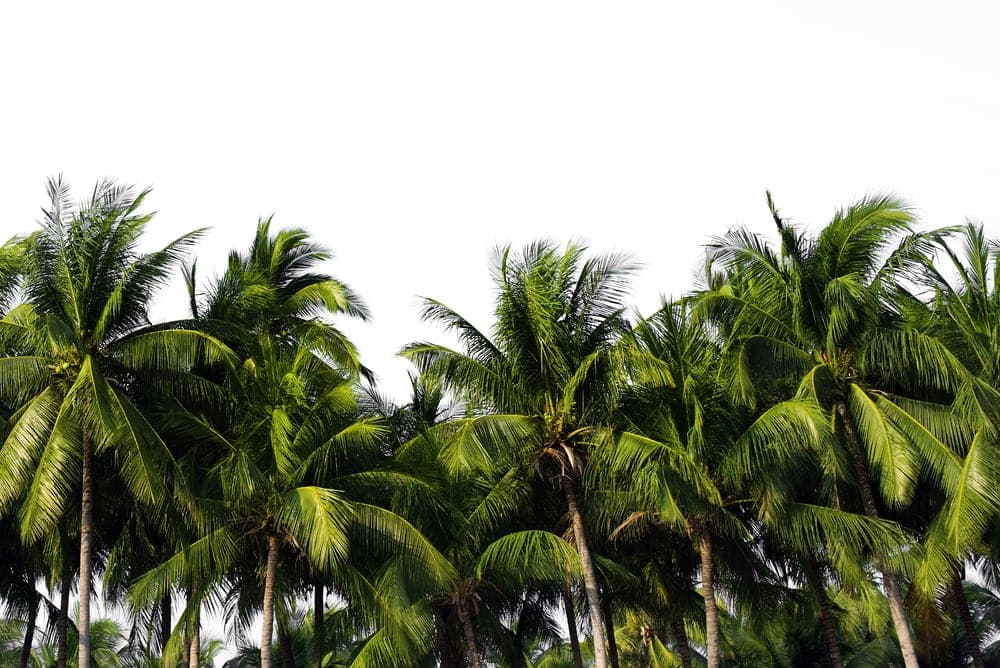
For our purposes, we have broken up these palm trees into our own categories. They are not all the same as the way researchers have broken them down.
Small Palm Trees
These palm trees are often referred to as dwarf or miniature palm trees. These stay on the smaller side of the palm tree world, although they can grow to 20 feet (6 meters). These are also the trees that generally grow the slowest which contributes to their shorter heights.
1. Mazari Palm (Nannorrhops ritchiana)
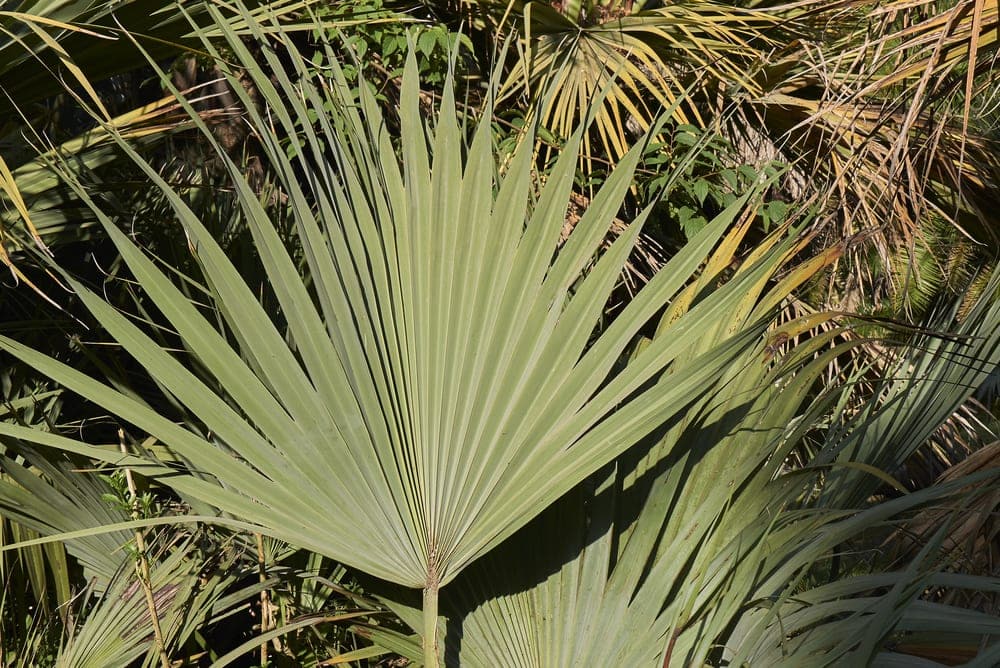
The Mazari Palm tree is also a very shrub-like palm. You can find these trees in southwestern Asia. It has clusters of leaves along the stems that look like fans. These leaves grow to be very big and can get up to 1-4 feet (0.3 – 1.2 meters) a piece.
Probably the most striking part of these palms are the colors of their leaves. The colors are silvery green or blue in color. The way the leaves are long and tapered almost give it a silk-like appearance.
Like many other palm species, the Mazari Palm can survive in temperatures as low as 10 degrees Fahrenheit (-12.22 degrees Celsius). Still, they thrive best when they grow in hot environments.
2. Cat Palm (Chamaedorea cataractarum)
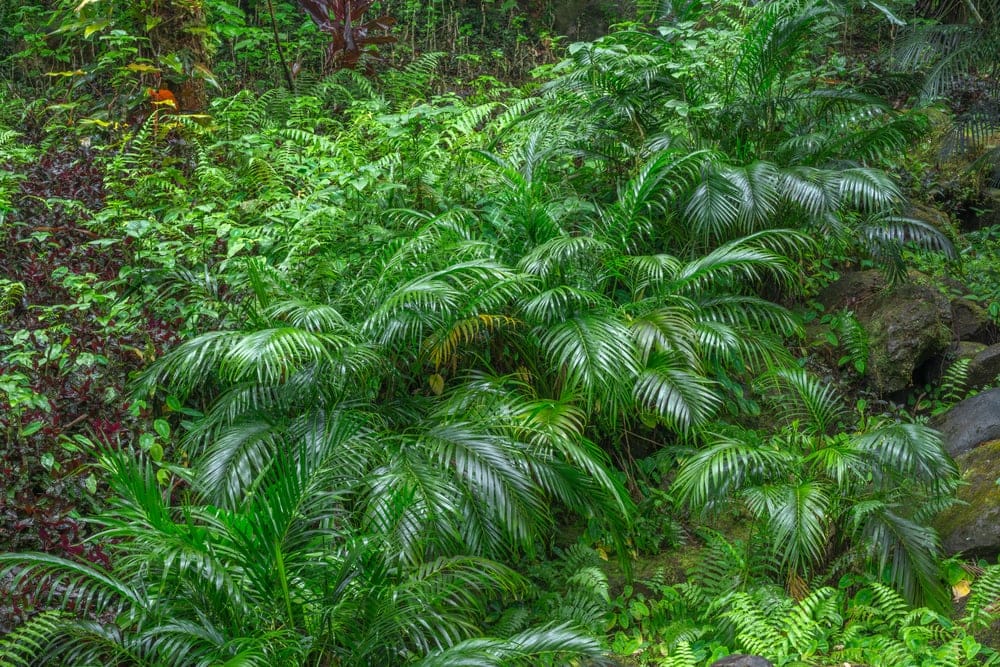
This palm tree is so small that it closely resembles a shrub. The trunk is nonexistent. Instead, the tree is thickly covered in broad leaves. The leaves are on very thin stems that reach out towards the ground.
The Cat Palm will only grow to be about 6 feet (2 meters) high. As it ages, the thick tree will begin to form a dense brush of shiny, thin leaves. The tree will also produce yellow, round flowers. When pollinated, small green palm fruits will be produced. As they ripen, they will turn into black drupes about half an inch long.
These trees fare best in warmer climates, but they can survive in colder temperatures as well.
3. Triangle Palm (Dypsis decaryi)
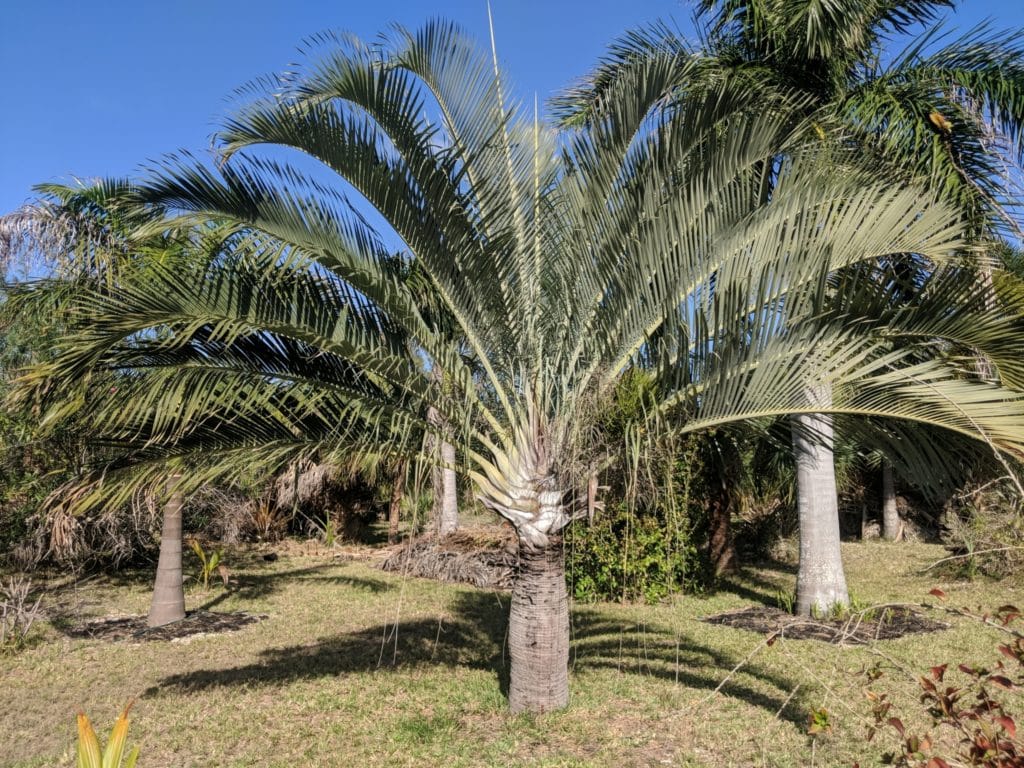
These palm trees are really interesting to look at because they really take on the shape of a triangle. The trunk is thick and fairly short. The main spectacle is the leaves which begin growing on the trunk with thick bases.
From there, the long leaves fan out to the sides of the tree, creating a wide, triangular-fanned shape. The leaves themselves can grow to be up to 8 feet (2.4 meters) long. The reason the leaves from a triangular shape is because the leaflets point out at a 120-degree angle.
These palm trees grow best in tropical and subtropical regions.
4. Mediterranean Dwarf Palm (Chamaerops humilis)
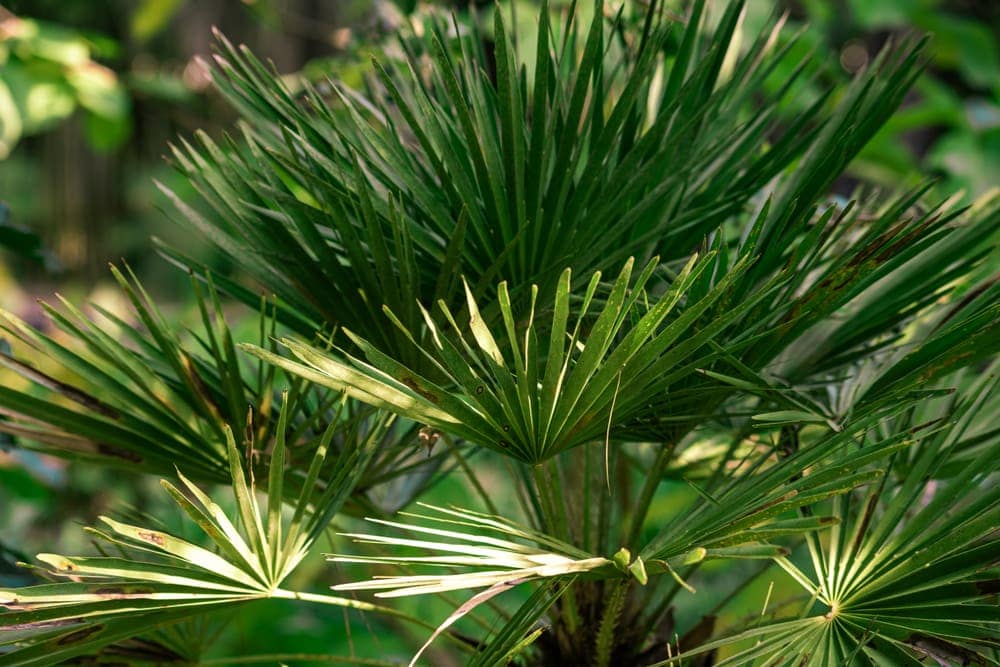
These are very unique looking palm trees. Several trunks sprout up from the base at varying heights, although they all stay quite short. These trunks also have a lot of light-colored, spiky protrusions coming from the trunk. Thick, fan-like leaves sprout from the top, giving the tree a very bushy and disorganized appearance.
The Mediterranean Dwarf Palm is a small tree, only growing to be about 10-20 feet (3-6 meters) tall. It does grow flowers as well, and it is able to withstand the cold very well. Although it can survive in temperatures as low as 10 degrees, it does best under hot sun.
5. European Fan Palm (Chamaerops humilis)
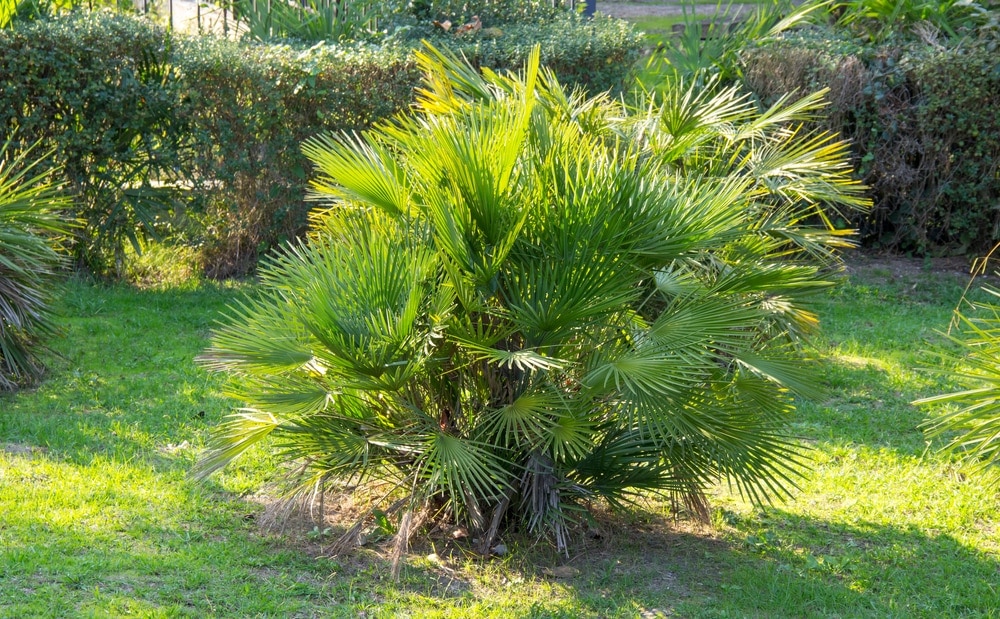
This palm tree is also sometimes referred to as the Mediterranean Fan Palm. It is a very small tree, growing only up to 10 feet (3 meters) tall. The tree has multiple trunks and semi-circular leaves. The leaves range in colors of green from olive and blue-green. Some of the leaves even appear to have a silvery hue to them.
Because it’s native to the Mediterranean region, it’s very adaptable and can live under many different circumstances. It can adapt to live in almost any kind of soil and is very hardy. Once it is established, it does not require a lot to survive.
This tree is so hardy that it has a high tolerance for drought and can even withstand temperatures as low as 10 degrees Fahrenheit (-12.22 degrees Celsius).
6. Bottle Palm (Hyophorbe lagenicaulis)
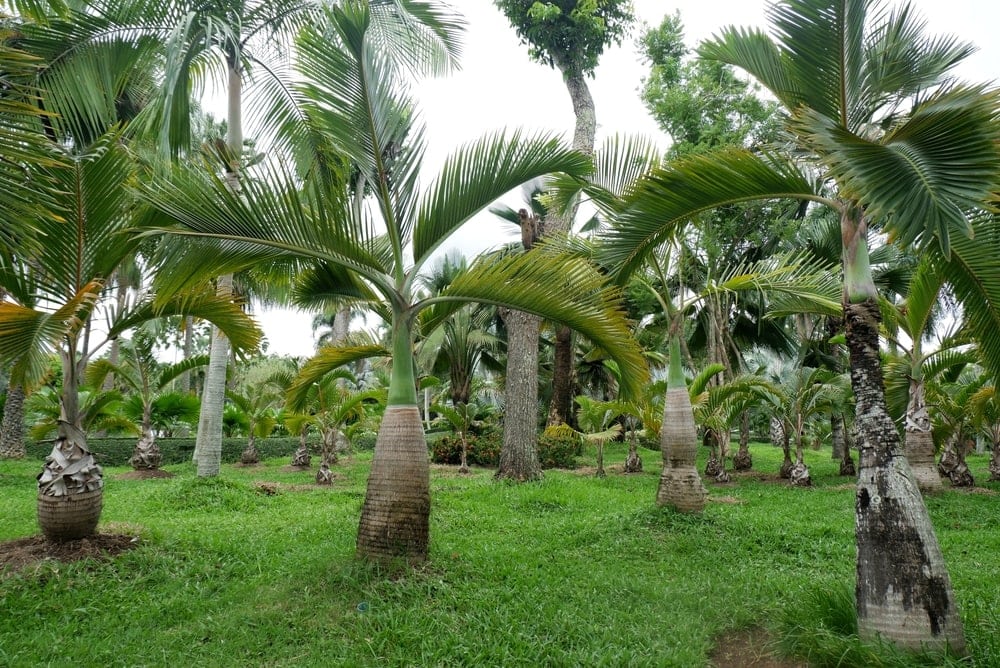
These palm trees are from the Mascarene Islands. Its name comes from its very uniquely shaped trunk. It is wide at the bottom and tapers off at the top, just like a bottle. This tree is very slow growing and will only reach up to 12 feet (4 meters) tall. At the top of the tree are large, arched leaves. The green coloration of the leaves is accented by the glossiness of the leaves.
These palm trees like to live in full sun and they can tolerate salt very well. What they cannot tolerate is too much cold, and they will become damaged if they find themselves in cold weather.
7. Lipstick Palm (Cyrtostachys renda)
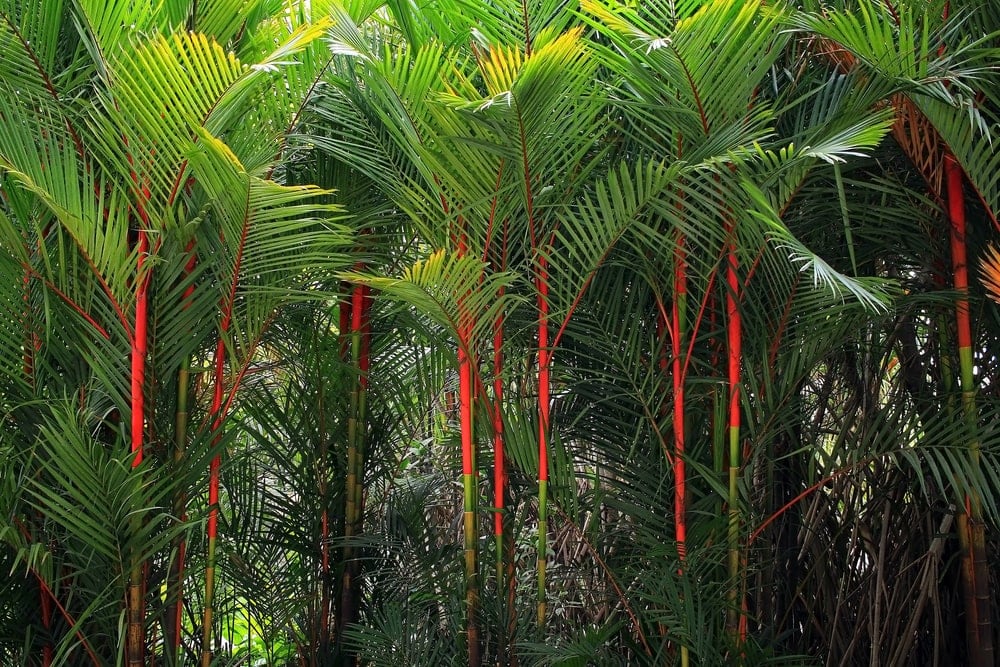
This palm tree is also sometimes referred to as the Sealing Wax Palm and is native to Southeast Asia. People began calling it a “lipstick” palm because of the shaft that runs through the leaf stem. The shaft is bright red, resembling that of a lipstick tube.
These trees stay quite small, only reaching heights of up to 15 feet (4.5 meters). However, it’s extremely adaptable and can live in a wide range of climates.
8. Pindo Palm (Butia capitata)
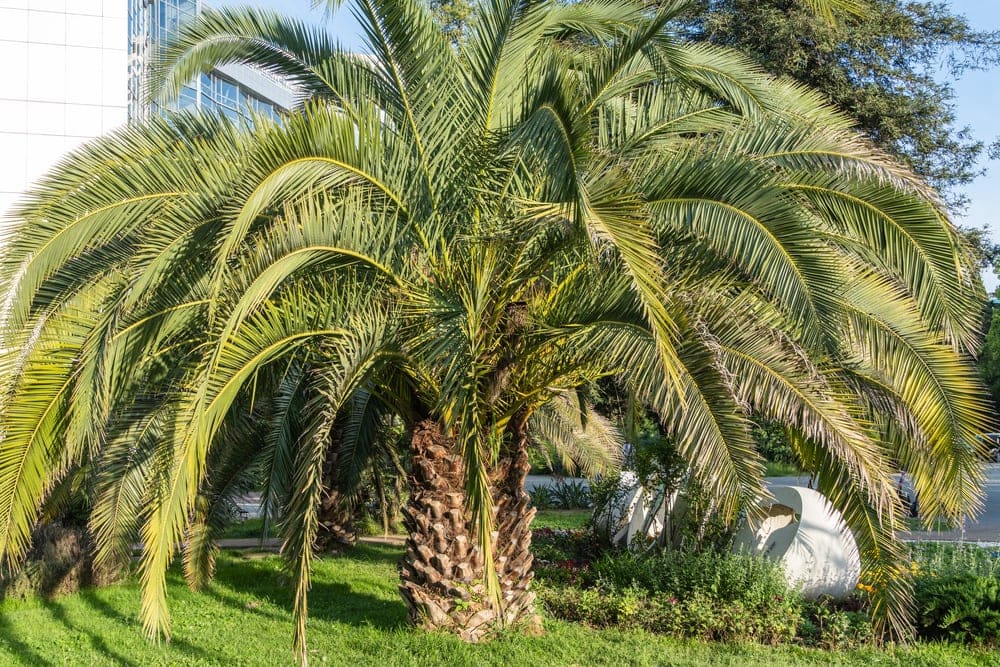
The Pindo Palm comes from Brazil, and is sometimes called the Jelly Palm. It is called the jelly palm because it grows fruit that is so sweet that it almost tastes like jelly.
These trees are also very cold-tolerant and can survive in temperatures as low as 10 degrees Fahrenheit (-12.22 degrees Celsius). They are also drought tolerant and are very adaptable to their surroundings.
The trunk of this tree grows very thick, with a diameter of 18 inches (0.46 meters). The trunk is surrounded by the bases of old leaves, making it appear spiky. The tree is topped with leaves blue-green in coloration.
9. Pygmy Date Palm (Phoenix roebelenii)
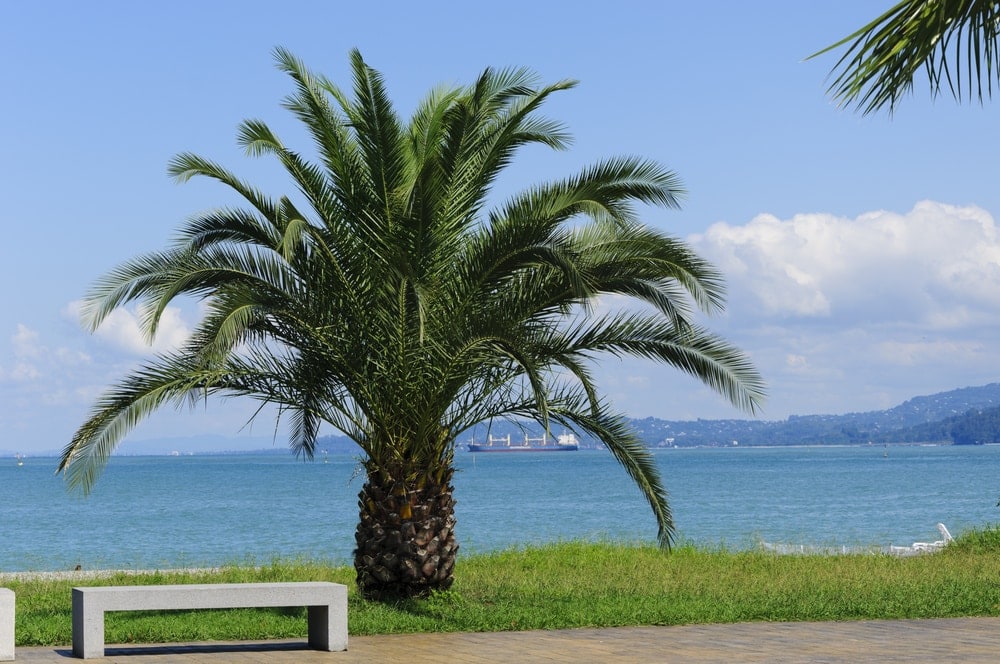
These trees are very small, but their tiny stature allows them to be adaptable to a lot of surroundings. It is a slow-growing tree that only reaches a height of up to 10 feet (3 meters) tall.
The crown that tops the trunk is thick with numerous shiny leaves. The leaves are a deep green color, and each leaf has sharp spines along the stems.
These trees grow ornamental flowers in subtropical landscapes. They also produce dates, but these dates don’t taste good like the ones produced from other palm trees.
The Pygmy Date Palm needs lots of moisture and sun, but it can tolerate temperatures as low as 30 degrees Fahrenheit (-1.1 degrees Celsius).
You May Also Like: Learn to Identify Edible to Poisonous Types of Mushrooms Here with Photos, Infographics, Guide, and more!
Fast Growing Palm Trees
These are going to be the trees that grow faster than any others. Many of these trees can grow up to 2.5 feet (0.8 meters) per year.
10. Carpentaria Palm (Carpentaria acuminata)
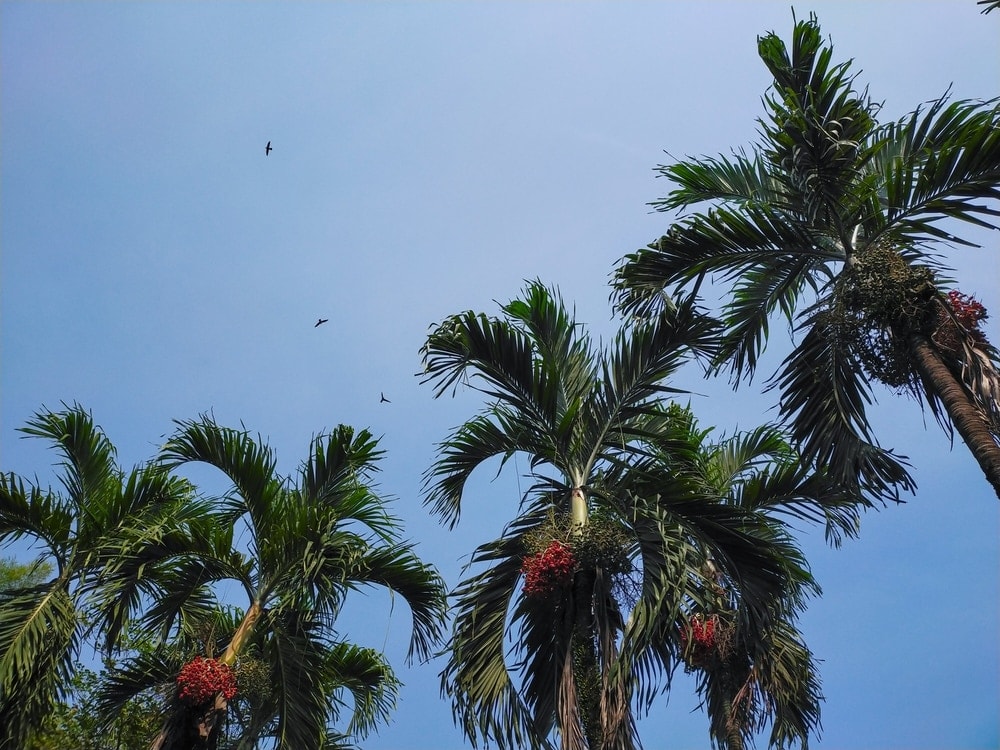
These trees are native to Australia. Each tree has one trunk that is very skinny and long. The bark is very smooth, and the leaves that top the tree are large and arch down towards the ground.
These trees grow very quickly, up to 3 feet (0.9 meters) a year. At their full height, they can reach heights of up to 30-40 feet (9-12 meters) tall.
These trees aren’t nearly as hardy as some of the others we’ve mentioned. They’re highly sensitive to the cold and they cannot handle the demands of a drought.
11. Foxtail Palm (Wodyetia bifurcata)
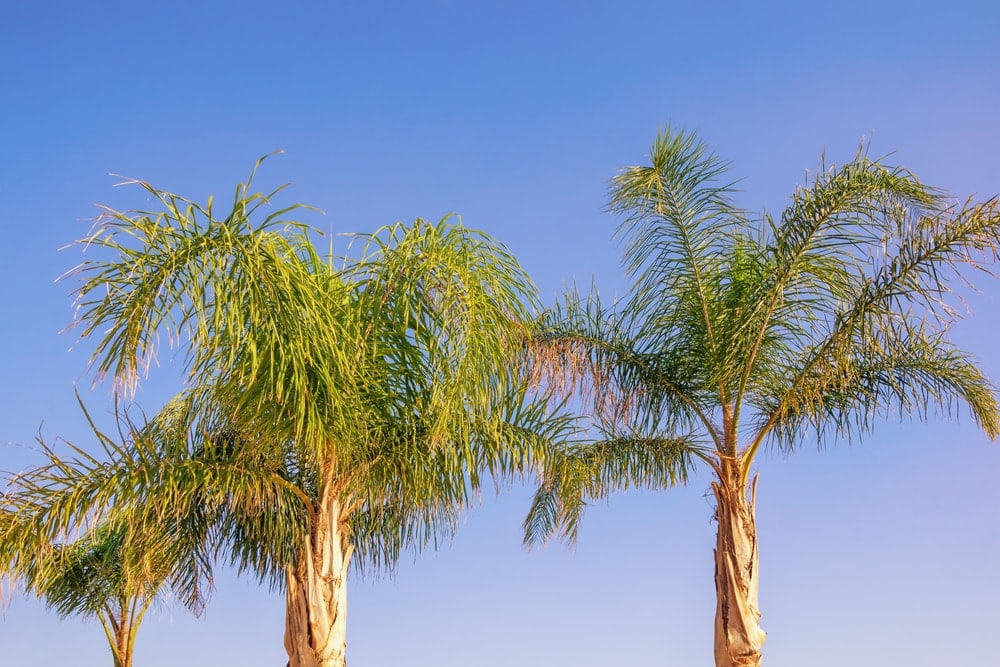
The foxtail palm gets its name from its leaves. The foliage appears spik, and they hang over the tree in clumps. The bushiness of the leaves makes it look just like a foxtail.
These trees are native to Australia. It grows very quickly, but only reaches about 20 feet (6 meters). Some of the largest trees may reach a maximum height of 30 feet (9 meters).
Not only does it grow very fast, but it can also survive in a range of environments. It can grow in almost any kind of soil, and it can survive under colder conditions. However, it is picky about how much light it gets, and likes to constantly be in full sun.
12. Majesty Palm (Ravenea rivularis)
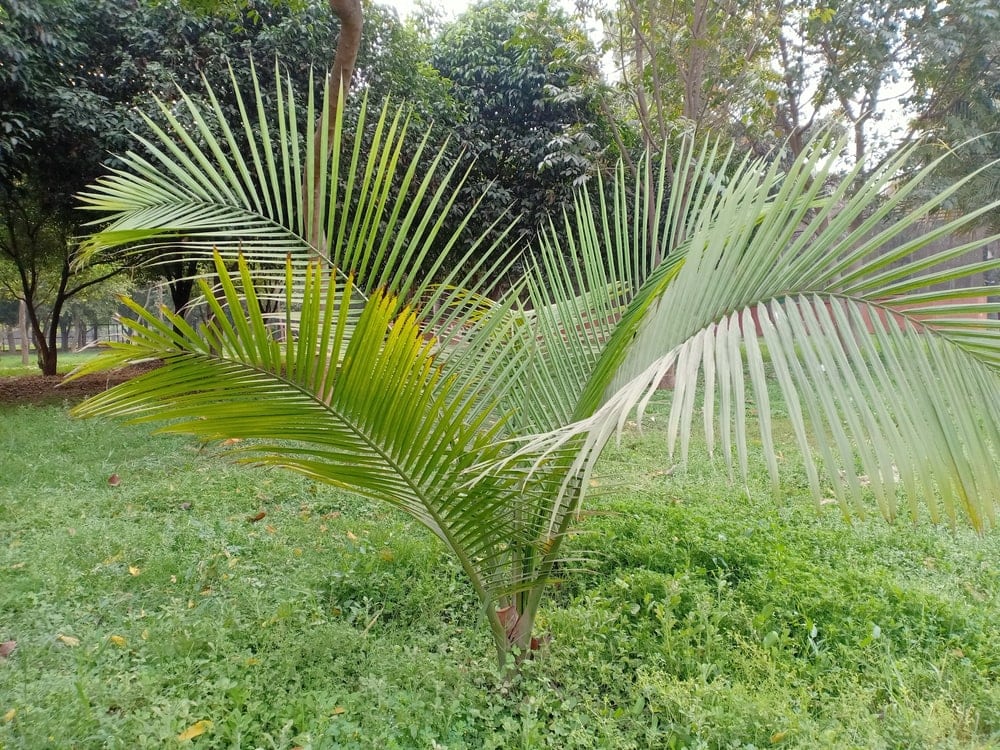
It’s no wonder this tree is referred to as the “majesty” palm. Its thick base leading to sprawling leaves makes it look like royalty.
These trees grow incredibly fast, growing up to 1 whole foot a year. They will keep up this growth rate for the first ten years before they slow down.
Overall, the tree can reach up to 35 feet (11 meters), but most of these palms stay around 20 feet (6 meters). They don’t like to be in direct sun, but prefer some shade. They also need fertile soil conditions to thrive.
13. Mexican Fan Palm (Washingtonia robusta)
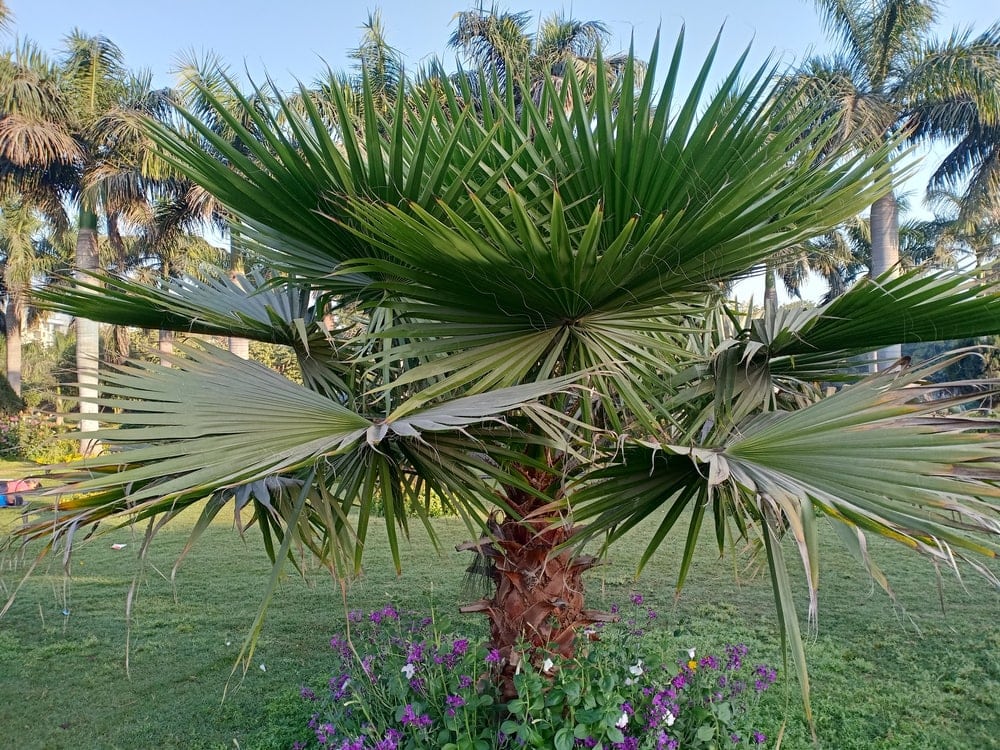
This tree is sometimes also called the “skyduster”. This is presumably because the leaves cluster together so that they resemble a feather duster.
This tree is another fast-growing palm, but as the name suggests, it is native to Mexico. When it is living in perfect conditions, it can grow up to 2 feet (0.6 meters) a year — an extraordinary feat. At its tallest, it can reach 70 feet (21 meters).
Not surprisingly, these trees are very adaptable which probably aids in them growing so tall. They can survive in a wide range of soils. They can also easily survive through both droughts and cold temperatures down to 20 degrees Fahrenheit (-6.67 degrees Celsius).
14. Queen Palm (Syagrus romanzoffiana)
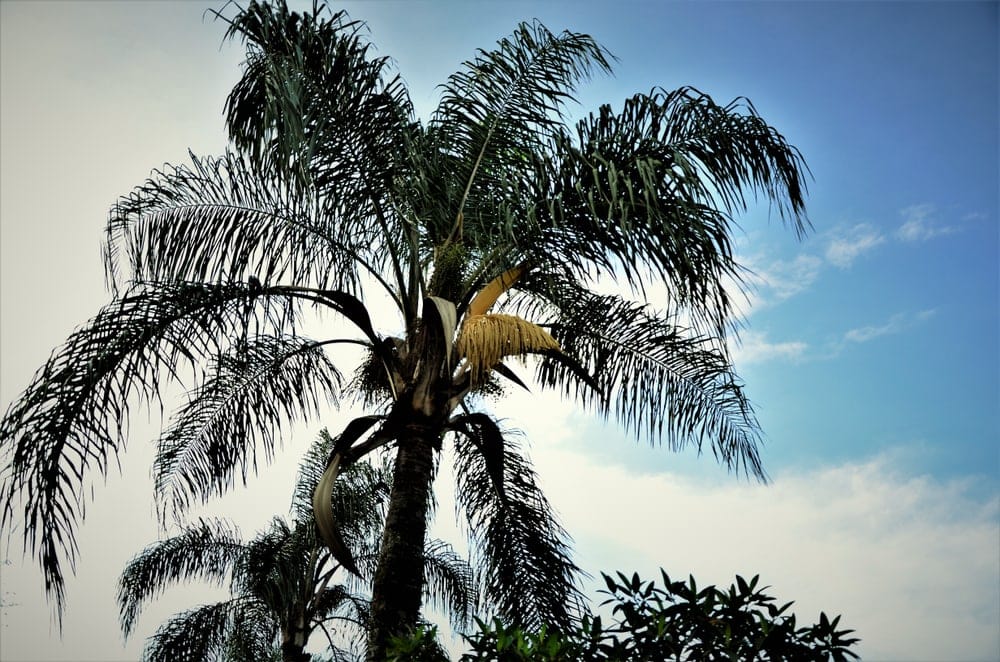
The queen palm is a shaggy tree also known as the Cocos plumosa and Jeriva syagrus romanzoffiana. These trees beat all the others in terms of growth rate, growing at up to 3.5 feet (1 meter) per year! At this growth rate, the trees can grow a total of 25 feet (8 meters) in only 7 years.
This tree also loves lots of sun, but it is hardy and isn’t very susceptible to disease.
Cold Tolerant Palm Trees
These trees are commonly referred to as “Cold Hardy Palms” because they can survive in temperatures as low as 5-20 degrees Fahrenheit (-15 to -6.67 degrees Celsius).
15. Bismarck Palm (Bismarckia nobilis)
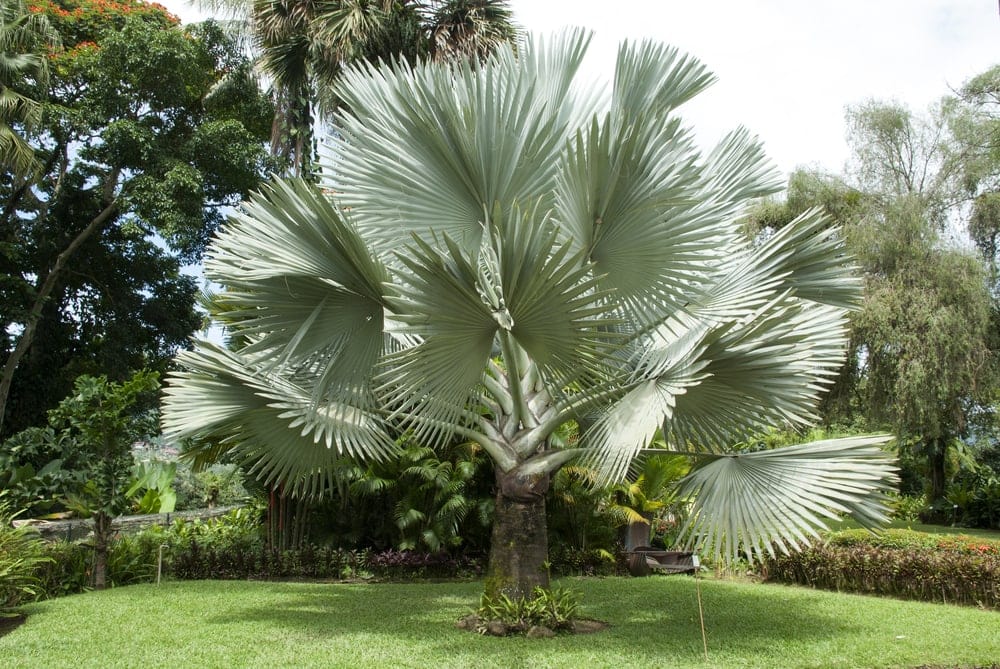
These palm trees are one of the most impressive looking palms. It looks quite different from a “traditional” palm, having a very short stature. Along with its stubby heights, it is surrounded by large, reaching leaves that surround the base. The foliage is so dense that it almost looks like a bush.
Even more remarkable than its appearance is the temperatures it can withstand. It can handle even the most extreme temperatures as low as 15 degrees Fahrenheit (-9.5 degrees Celsius).
16. California Fan Palm (Washingtonia filifera)
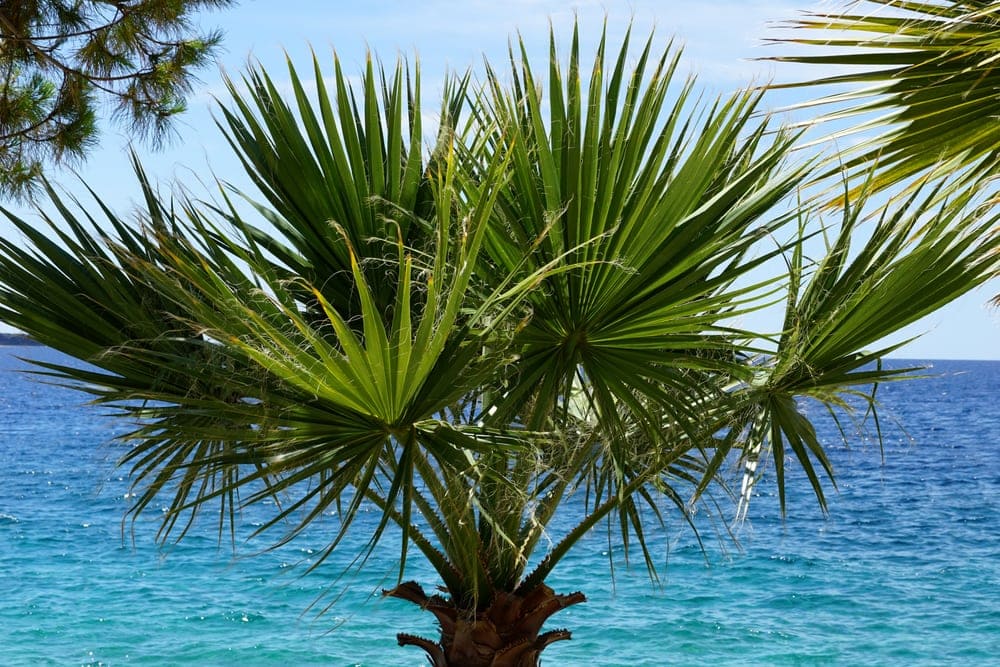
These are also very interesting looking palm trees. Like the Bismarck palm, they’re very short. The leaves aren’t as thick and are rather sparse, with large gaps in between each leaf. Still, this adds to its unique look because the leaves are very spiky in appearance. They almost resemble a crown with spindly tips.
This tree is also sometimes known as the Desert Fan Palm and can tolerate temperatures as low as 15 degrees Fahrenheit (-9.5 degrees Celsius). This is a very hardy tree — it’s cold-tolerant, but it’s also very drought tolerant.
17. Chinese Fan Palm (Livistona chinensis)
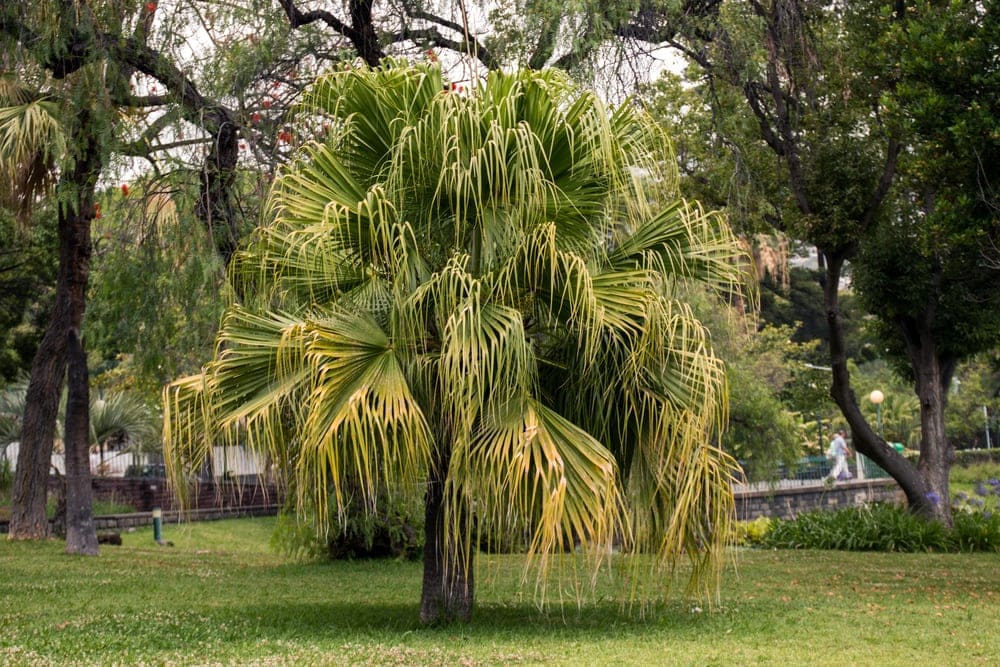
Having an interesting appearance seems to be a trend amongst these cold-tolerant palms. The leaves of the Chinese palm are similar to the California fan palm. They are large leaves that are wide and spiky like a crown. However, the tips of their leaves point downwards, resembling curled fingers.
These trees can also withstand temperatures down to 15 degrees Fahrenheit (-9.5 degrees Celsius), and it can survive through droughts. It is also adaptable in a wide range of soils.
18. Needle Palm (Rhapidophyllum hystrix)
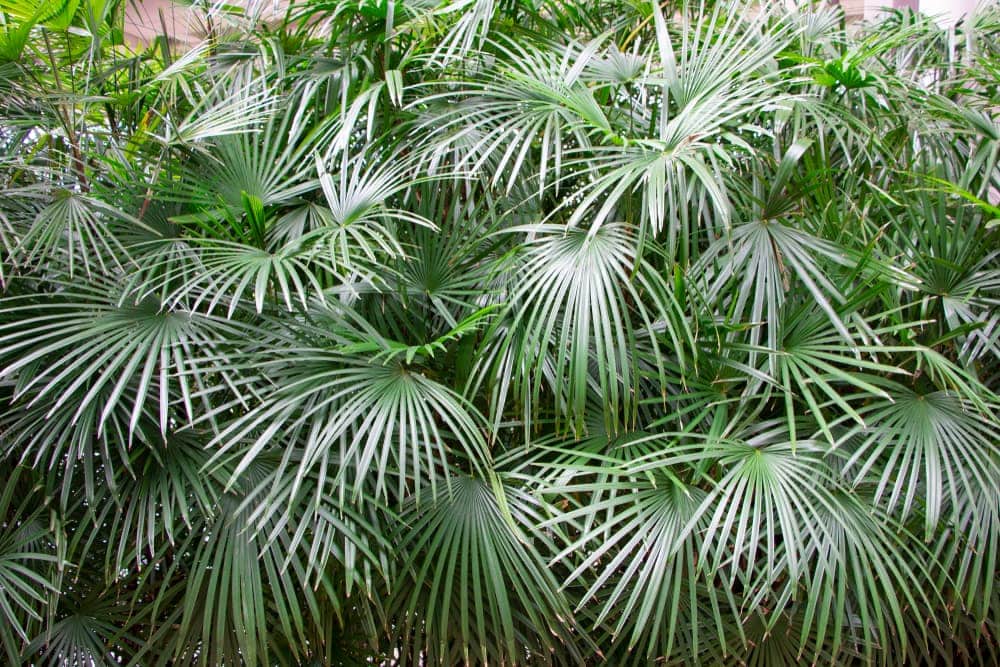
This palm tree is also sometimes known as the Porcupine Palm because it’s so short. It almost doesn’t appear to have a trunk. Rather, it’s surrounded by several, long and pointed leaves.
These trees can withstand the cold even better, living in temperatures as low as 10 degrees Fahrenheit (-12.23 degrees Celsius). It is also well adaptable to droughts and varying soils.
19. Windmill Palm (Trachycarpus fortune)
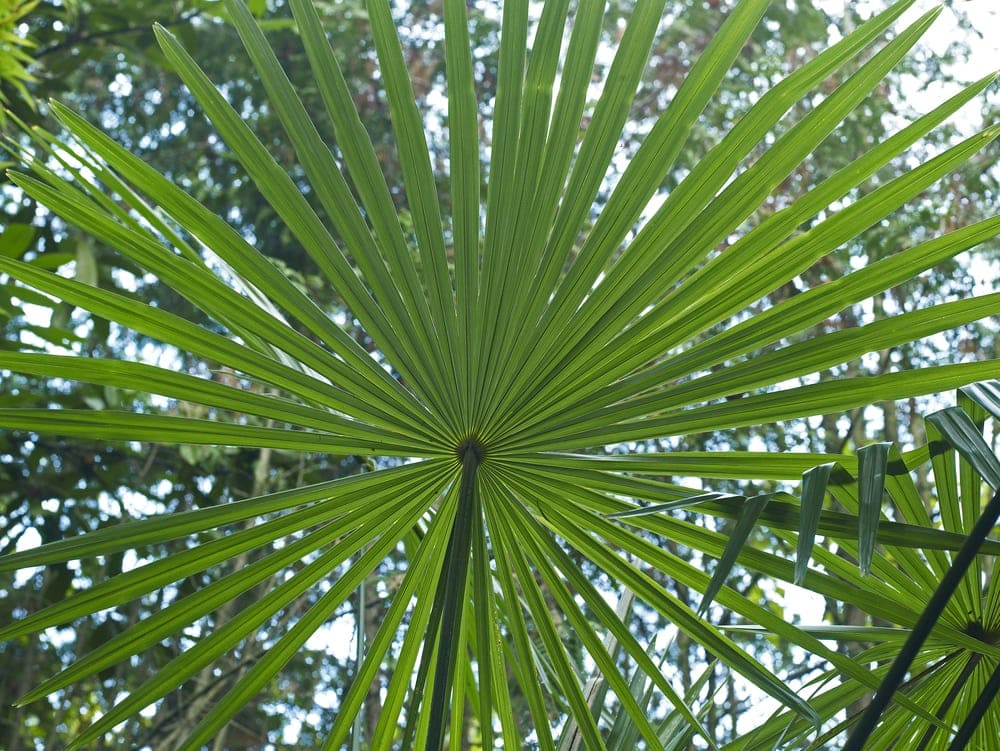
These trees also stay on the shorter side, and their trunks are quite spiky. These are one of the hardiest palm trees in the world, especially when it comes to withstanding temperature. It can handle temperatures down to an astounding 5 degrees Fahrenheit (-15 degrees Celsius).
Also, most palm trees that can withstand colder temperatures still prefer hotter climates. However, the Windmill Palm does not like hot temperatures at all and prefers to live where it’s cooler.
You may also like: Learn and Identify the Different Types of Leaves on Trees and Plants: Complete with Images, Facts, Descriptions, and More!
Fruit Producing Palm Trees
These are the palm trees that will produce fruit.
20. Acai Palm (Euterpe oleracea)
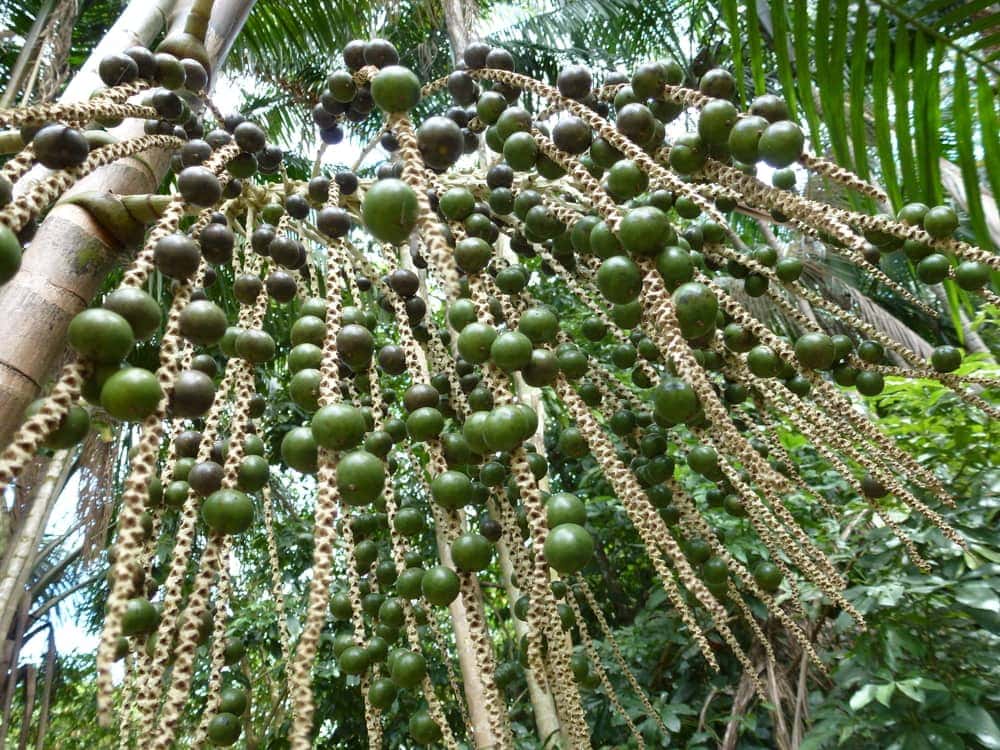
As the name suggests, these palm trees produce the Acai fruit. These fruits are becoming increasingly popular because of their sweet taste and nutritious properties. They are rich in antioxidants, omegas, and amino acids. Because of their beneficial properties, the fruit can often be found in energy drinks, weight loss products, and cholesterol products.
Still, these trees aren’t very hardy and cannot withstand cold temperatures or drought.
21. Coconut Palm (Cocos nucifera)
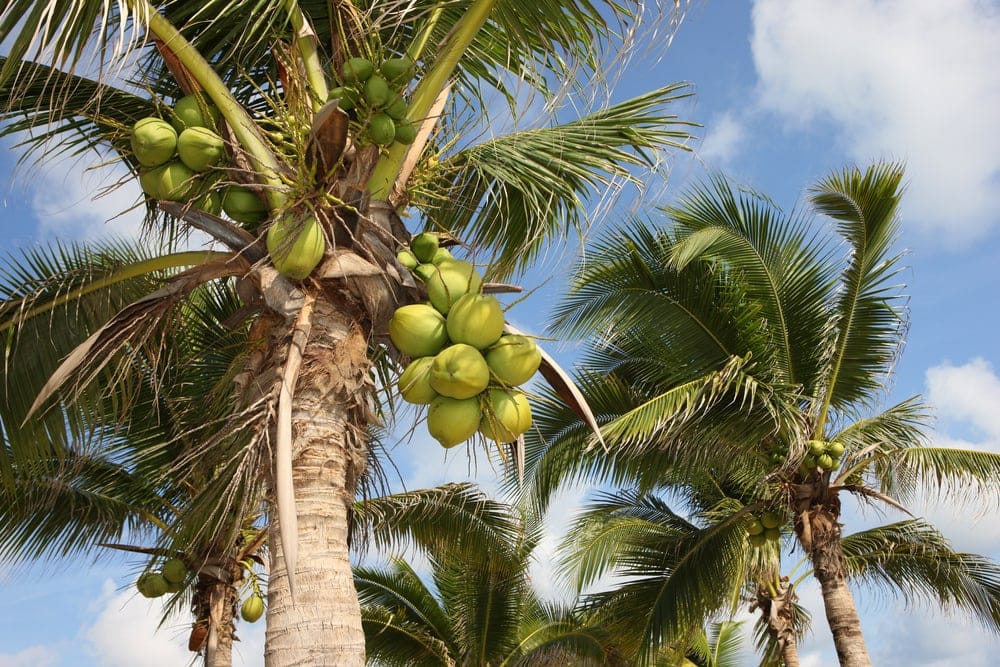
These are the trees that most people think of when you mention palm trees. These are the coconut-producing plants. People around the world love coconuts and they are important for people’s diets as well as for economics.
The outer, “meaty” part of the coconut is used in a lot of baked goods and beauty products. The watery insides of the coconut is called “milk” and people like to drink it. Manufacturing companies even use the outside husk of the coconut for production.
22. Date Palm (Phoenix dactylifera)
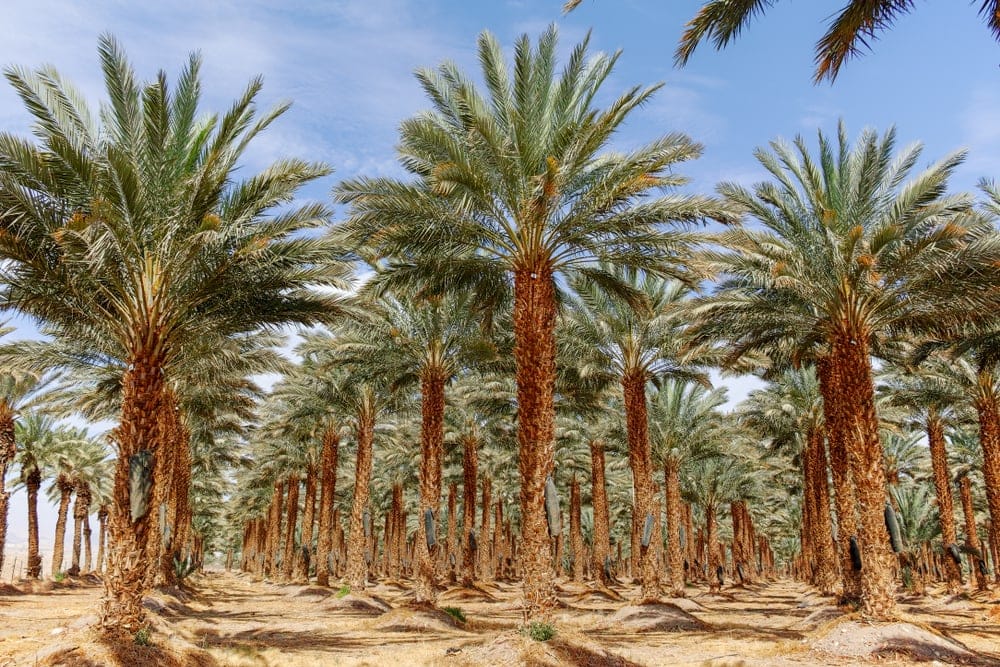
These trees have beautiful, sprawling leaves that hang out to the sides of the trunk. These trees produce the fruits called “dates” which are orange-red in color and are very popular across the globe.
People love these fruits because they’re very sweet, almost like a fig or a prune. They are commonly used in sweets like ice cream and syrups. People also use them in alcohol and vinegar.
23. Jelly Palm (Butia capitata)
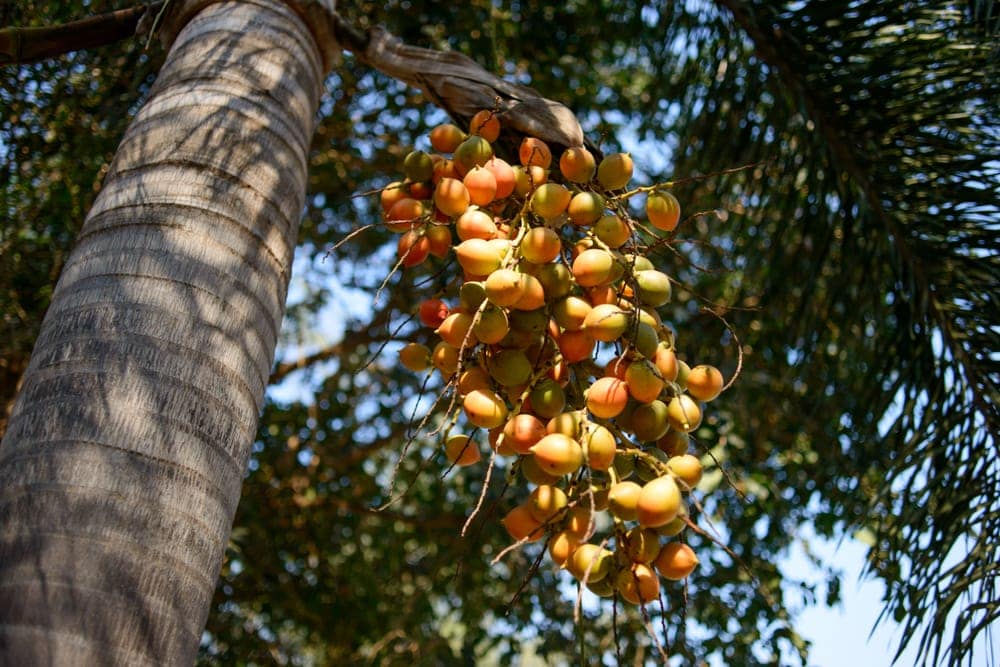
The Jelly Palm is a shorter tree with beautiful, long-hanging leaves similar to the Date Palm. These trees are some of the hardiest kinds of palm trees in the world. They are called “Jelly” Palms because of the incredibly sweet, orange jelly their fruit produces. Some people describe these fruits as tasting like a mix between pineapple and bananas.
These trees can reach up to 15-20 feet (5-6 meters) throughout their lives, but they are very slow-growing. They survive best when they are growing under full sun, but they do well in partially shaded areas as well.
24. Saw Palmetto Palm (Serenoa repens)
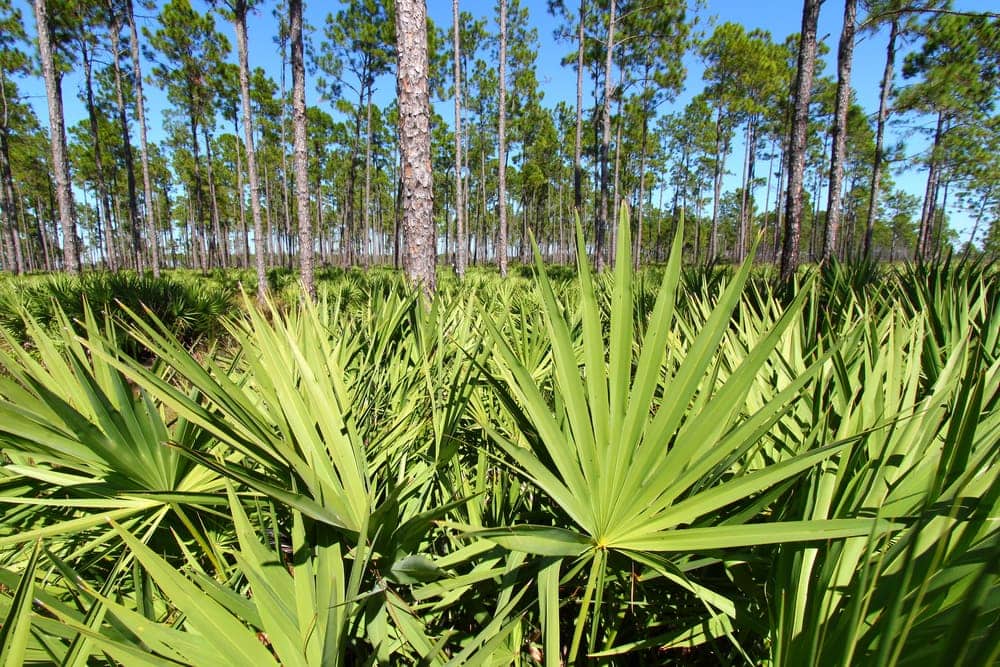
This is another palm tree that doesn’t look much like a palm tree at all. It more resembles a shrub because it’s trunk is very small and short. In fact, the long, grass-like leaves makes the tree resemble a fall bush of grass.
This tree produces berries of blackish-blue coloration. These berries are very important medically because they’re used to treat kidney, urinary, and prostate problems.
Besides these very important berries, the palm tree also produces beautiful yellow-white flowers. These flowers not only look nice, but they smell very sweet as well. Some people even use these flowers in creating honey.
The tree is also very cold tolerant which is great since the berries it produces is of considerable importance.
Drought Tolerant Palm Trees
Some plants can tolerate droughts very well, and others can’t. This goes for palm trees too. You might think that since palm trees primarily grow in warm, tropical regions that they can all tolerate drought.
However, this is incorrect. The palm trees that can easily survive drought adapt easily to change and are very hardy.
25. Areca Palm (Chrysalidocarpus lutescens)
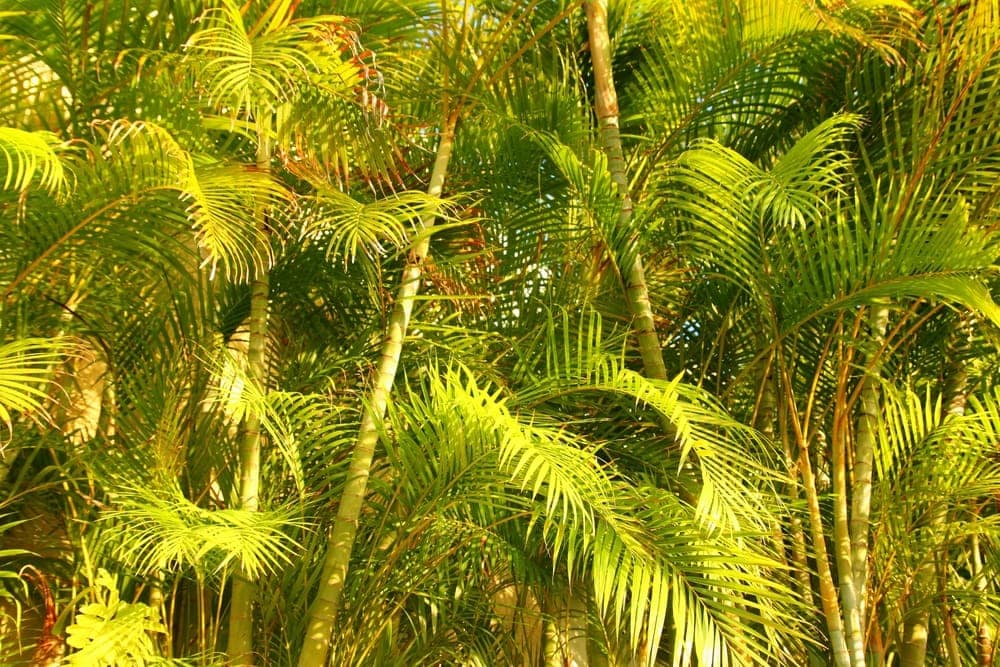
These palm trees have very thin trunks, almost so that they look comical against their larger leaves. The leaves are quite large and fan out to the sides and tops of the trunk.
Native to the islands of Madagascar, these trees prefer tropical and subtropical regions where they’ll be warm. Because it’s used to warmer climates, it’s also very tolerant of droughts, and it can survive in a wide range of soils.
26. Blue Hesper Palm (Brahea armata)

This is another palm tree that stays on the shorter side. Although they’re tall enough not to look like shrubs, their trunks are round and stubby. Lush, spiky leaves spread out in all directions atop the trunk, beautifully filling out the space. The leaves are a unique cool-blue coloration that aids to their beauty.
These trees are native to Mexico, so they’re quite drought tolerant. Unlike the Areca Palm that can survive in multitudes of soils, the Blue Hesper Palm is more picky. It needs alkaline soil to really thrive and does not do well with acidity.
27. Blue Latan Palm (Latania loddigesii)
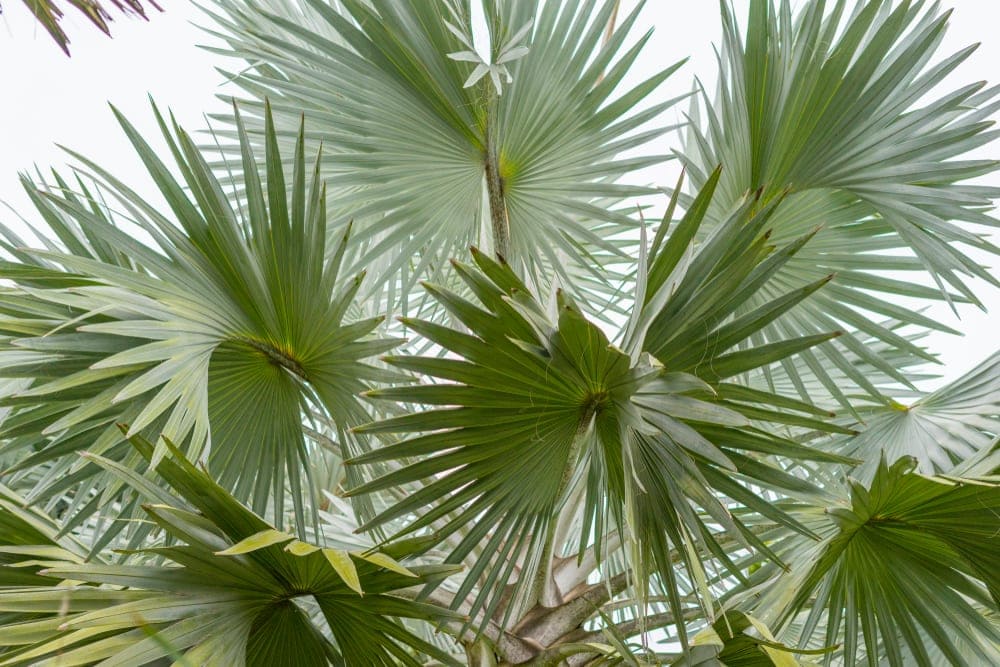
The Blue Latan Palm tree has a short, skinny trunk topped by enormous, sprawling leaves. There is significant space between each leaf, creating a unique look as they spread both towards the sky and the ground.
These palms are native to the island of Mauritius where it is incredibly drought tolerant and can live in a range of soils.
28. Canary Island Date Palm (Phoenix canariensis)
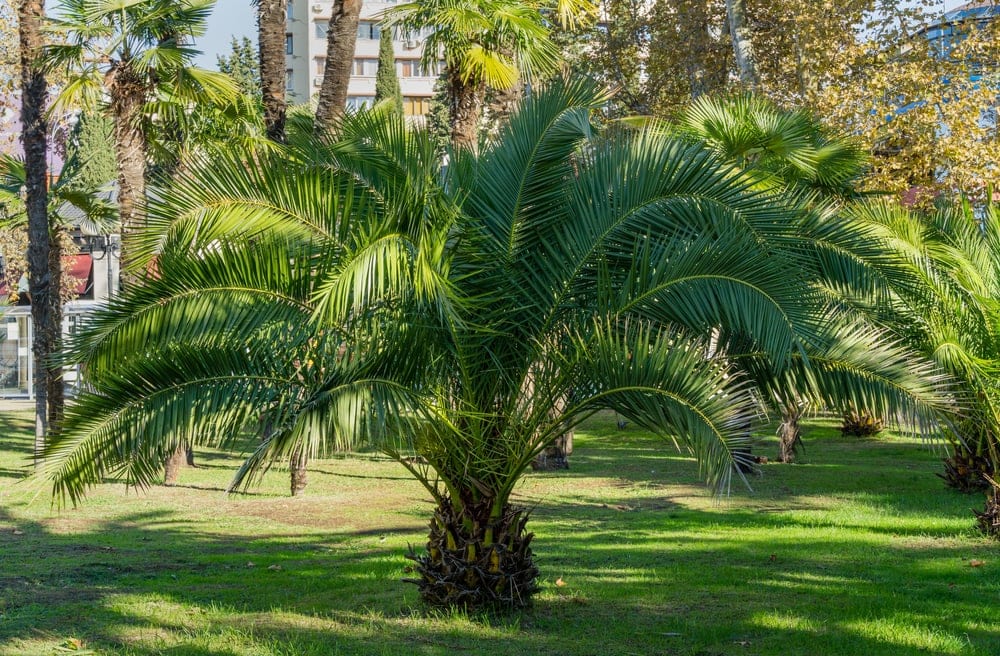
These trees are tall with thick trunks. The leaves are long and skinny, reaching towards the sky as well as below to the ground.
The Canary Island Date Palms are incredibly hardy, regularly enduring drought, inhospitable soil, and freezing temperatures. It can withstand almost anything that nature throws at it. Found on the Canary Islands of North Africa where the climate is harsh, these trees must learn to adapt.
29. Sylvester Date Palm (Phoenix sylvestris)
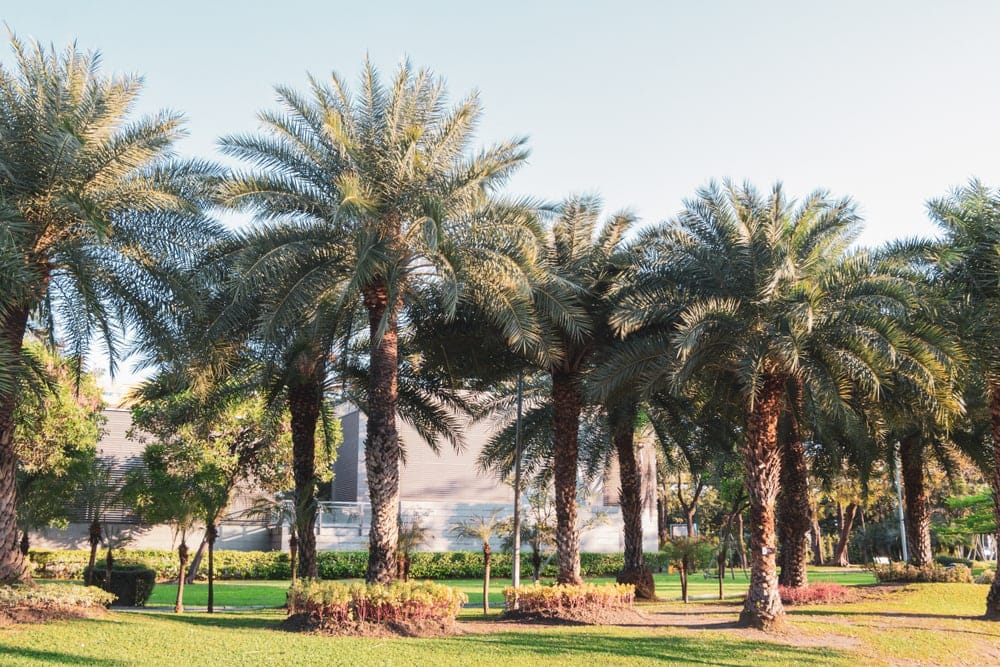
The Sylvester Date Palm is a tall tree with thick, skinny leaves reaching out of the top of the trunk. The spikes on the leaves are so thick that they almost resemble the needles found on pine trees.
These trees are found in India and can survive in a large range of soil. They can also last through tough droughts, and they can survive in the cold down to 15 degrees Fahrenheit (-9.5 degrees Celsius).
Salt Tolerant Palm Trees
Similarly, these palm trees are better at handling higher levels of salinity. This is especially important for trees that are growing along the coasts of oceans. Waves can often throw salty water into the air which will land on and around the trees. If the trees can’t handle the salt, they’ll eventually dry out and die.
30. Buccaneer Palm (Pseudophoenix sargentii)
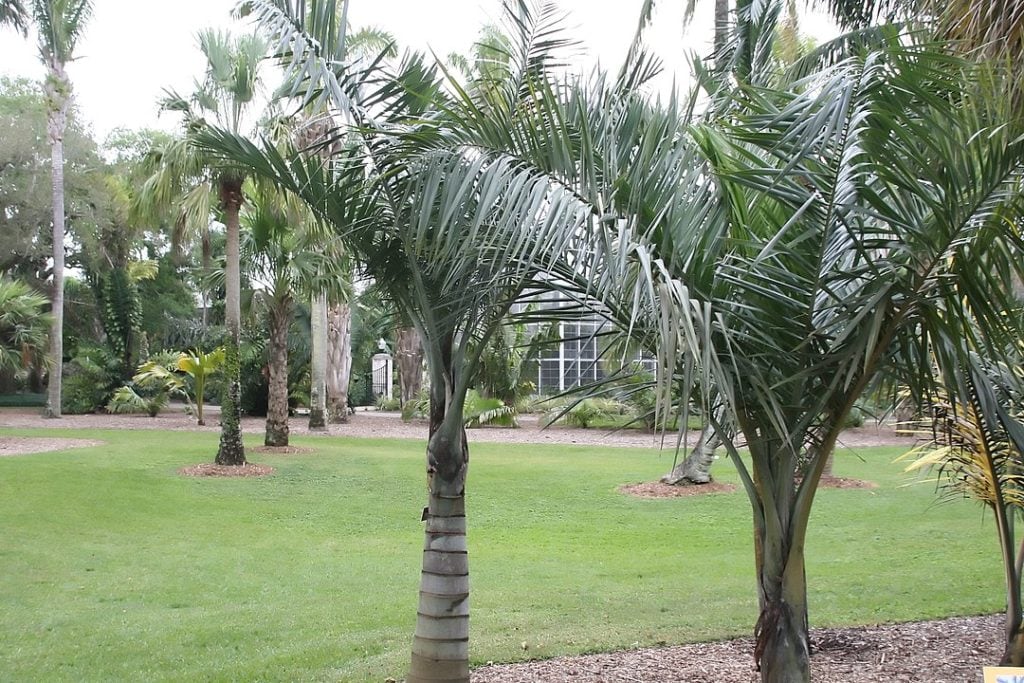
These trees are also very tall. Although their leaves are large, they are quite sparse, so the tree doesn’t appear to be very covered in foliage.
The Buccaneer Palm is native to Florida and is considered very durable. It is extremely salt and drought tolerant.
31. Cabbage Palm (Sabal palmetto)
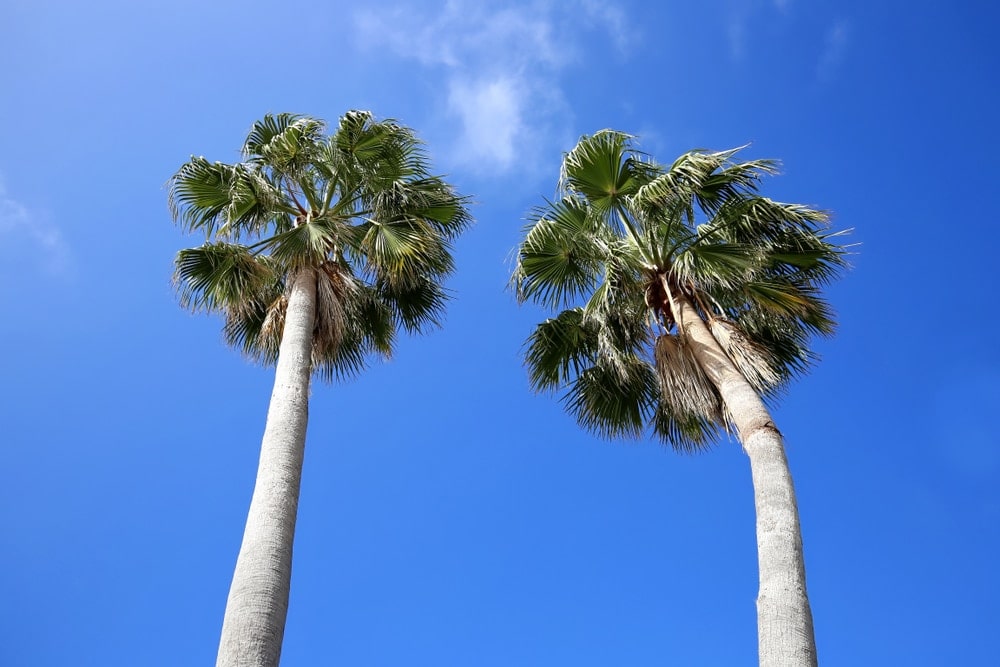
The Cabbage Palm also has very tall and thick trunks. They reach high up into the sky and they are topped by thick, shaggy leaves. The leaves are so thick that the top of the palm tree resembles a pom pom.
This is one of the most common types of palm trees found in the United States because of their extreme hardiness. It can withstand almost anything Mother Nature throws at it including salt, drought, and cold temperatures. They can withstand temperatures as low as 10 degrees Fahrenheit (-17.8 degrees Celsius) which isn’t very common among palm tree species.
32. Old Man Palm (Coccothrinax crinita)
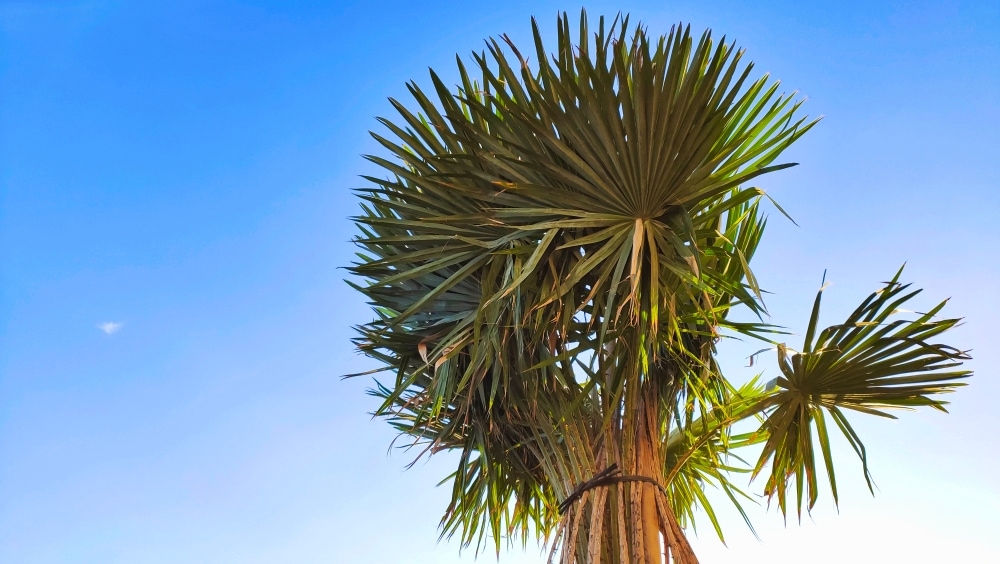
The Old Man Palm perhaps got its name because of its shaggy trunk. The trunk is thicker based, but is very short. It is covered in long, weaved fibers resembling ragged orange hair.
These palm trees aren’t drought tolerant, but they do easily adapt to alkaline soils and can withstand a large amount of salt.
33. Saw Palmetto Palm (Serenoa repens)
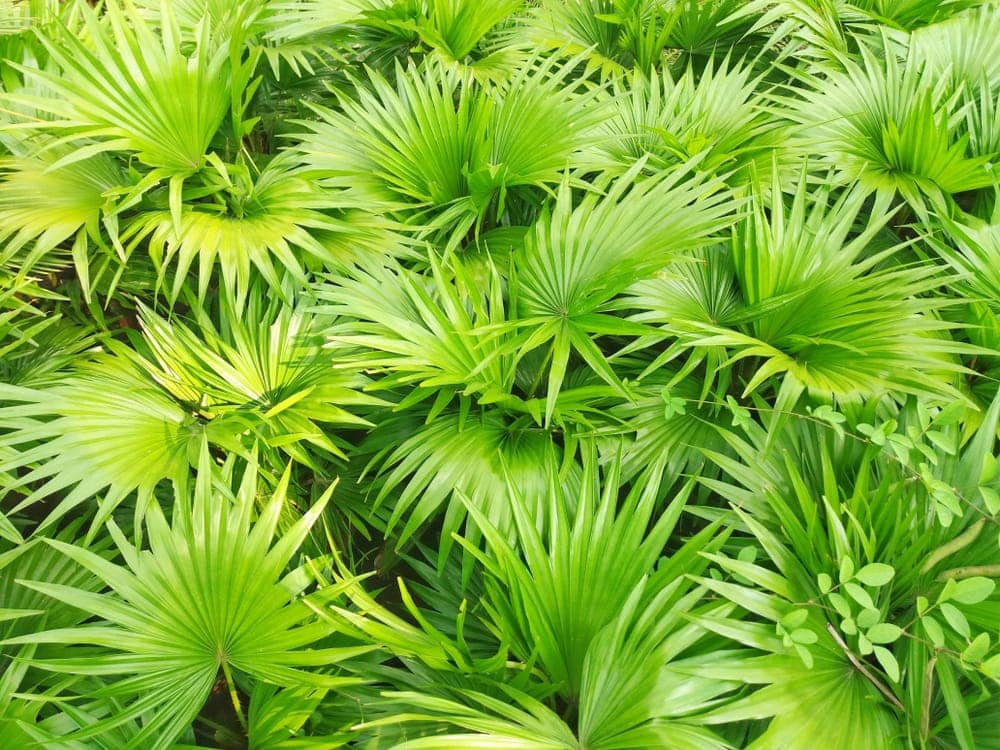
This is another palm tree that is very short and shrub-like. It is so small that it only reaches about 3-6 feet (0.9 – 2 meters) in height. It has groups of light green leaves that are long and finger-like.
These are one of the most durable palm trees because it can withstand almost anything Mother Nature throws at it. It can survive in the cold, in droughts, and saturated in lots of salt. It even produces edible fruits. They can survive in temperatures as low as 10 degrees Fahrenheit (-12.22 degrees Celsius) and have adapted to live in a large range of soils.
34. Spindle Palm (Hyophorbe verschaffeltii)
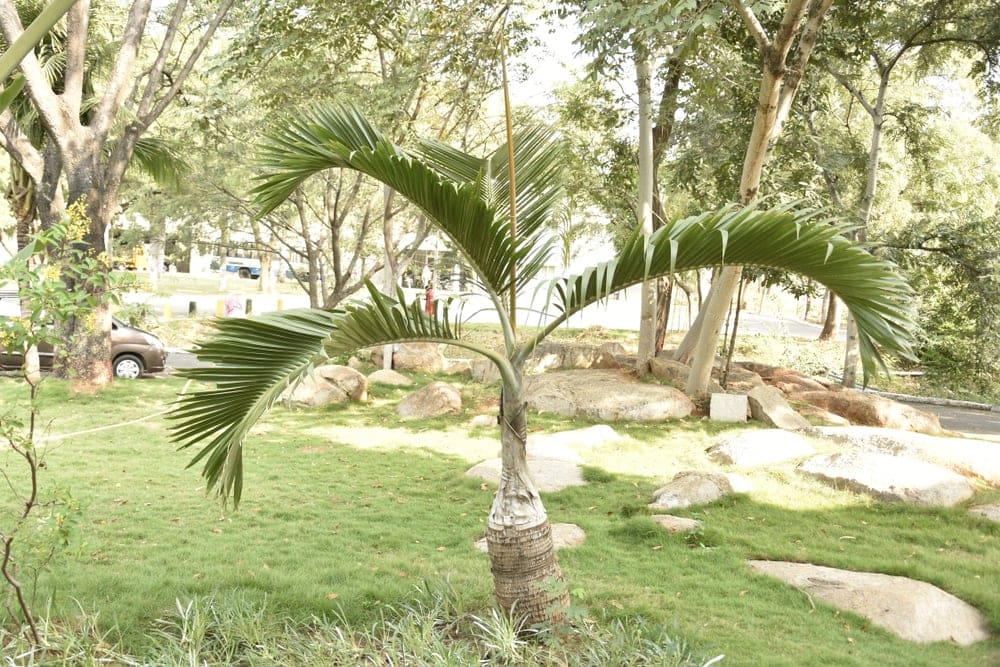
These trees are of medium height with thicker, oddly shaped trunks. The trunks are long, but many of them are thinner at the base and get sider near the top. Some of the trunks also appear to be a bit lumpy. At the top, the trees are covered in long, sprawling leaves that reach over the trunk like a wave.
Because it’s trunk is swollen, it is quite similar to the Bottle Palm. Still, it is different because it is hardier and grows taller. It is happiest when it is exposed to full sun, but it also adapts to a large range of conditions. It can also survive large levels of salt exposure.
You May Also Like: 21 Types of Plants to Know for Plant Lovers with Photos, Infographics, Facts and more!
Space Tolerant Palm Trees
These palm trees grow very well in small places. Sometimes, trees may become cramped between landmarks or other trees. This creates competition for resources, and some trees are better at handling that than others.
35. Areca Palm (Chrysalidocarpus lutescens)
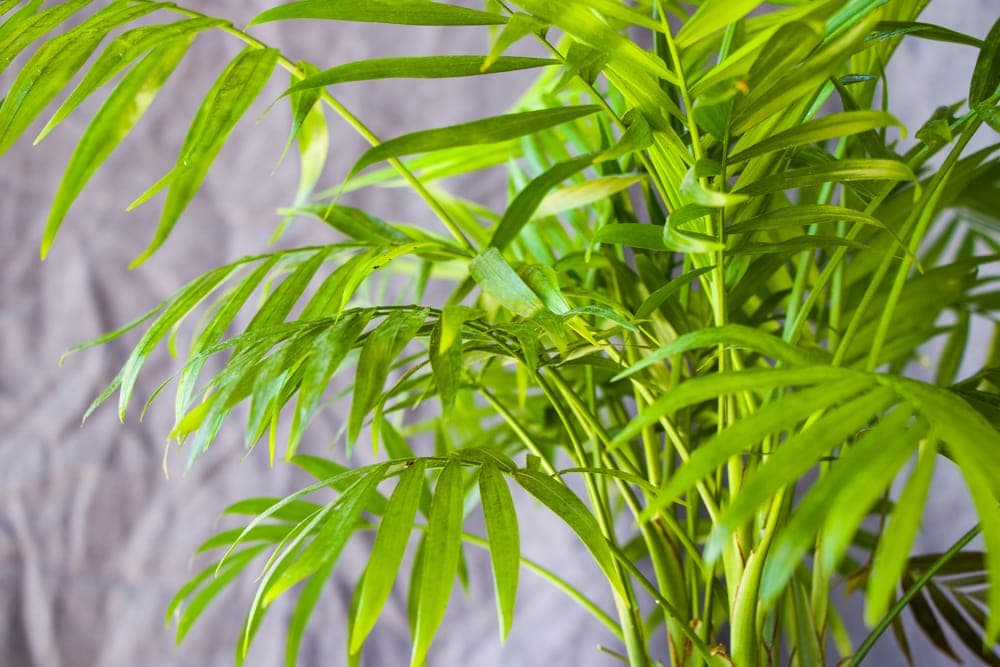
These trees stay quite small and are adept at surviving in compact spaces. It has multiple trunks that stay short, and broad leaves spring from all sides. Some people describe these leaves as looking like feathers because of the way the thin leaflets spread out from the base of the leaf.
The Areca Palm is relatively fast-growing for its size, growing up to 7 inches (0.18 meters) per year. Overall, it can grow up to 7 feet (2.1 meters), but it will often stay much smaller.
Unlike many other palms, the Areca Palm is not very hardy and requires a lot of specifics. To be happy, the tree needs lots of light, but prefers to not be in direct contact. It also needs a lot of water.
36. Bamboo Palm (Chamaedorea seifrizii)
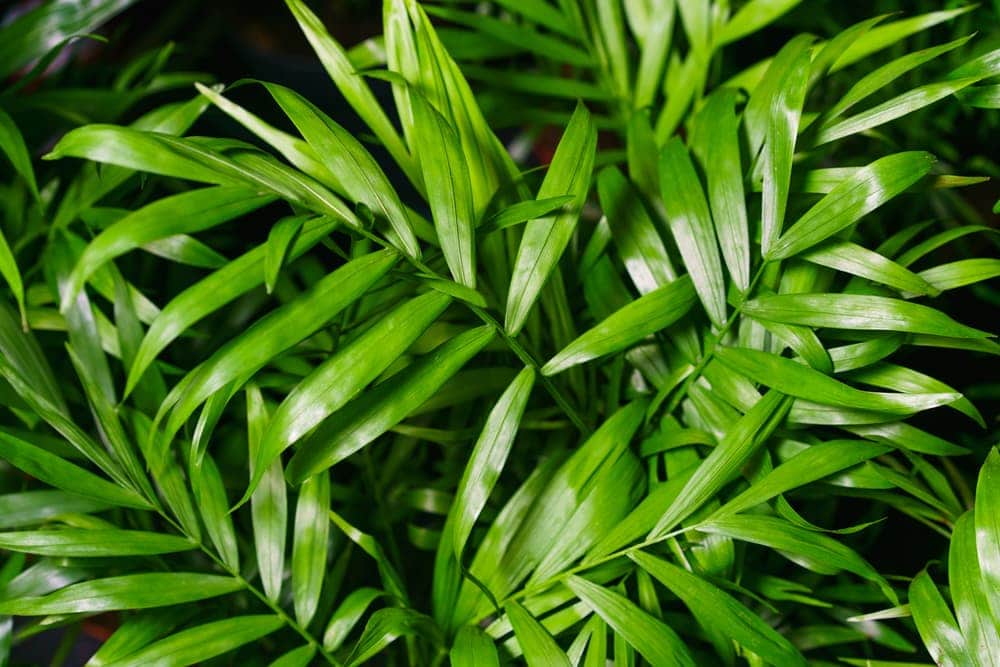
The Bamboo Palm is named as such because it looks just like bamboo. Several trunks spring up from the soil where they will grow long, tall, and skinny. The leaves are broad with skinny leaflets, and they are a deep green coloration.
This palm variation is very hardy because it doesn’t need a lot of light to be happy. It also can withstand low levels of humidity and poor soil conditions.
These palms grow to be quite large despite the smaller places they often find themselves in. They can become up to 10 feet (3 meters) tall and 4-5 feet (1.2 – 1.5 meters) wide.
37. Kentia Palm (Howea forsteriana)
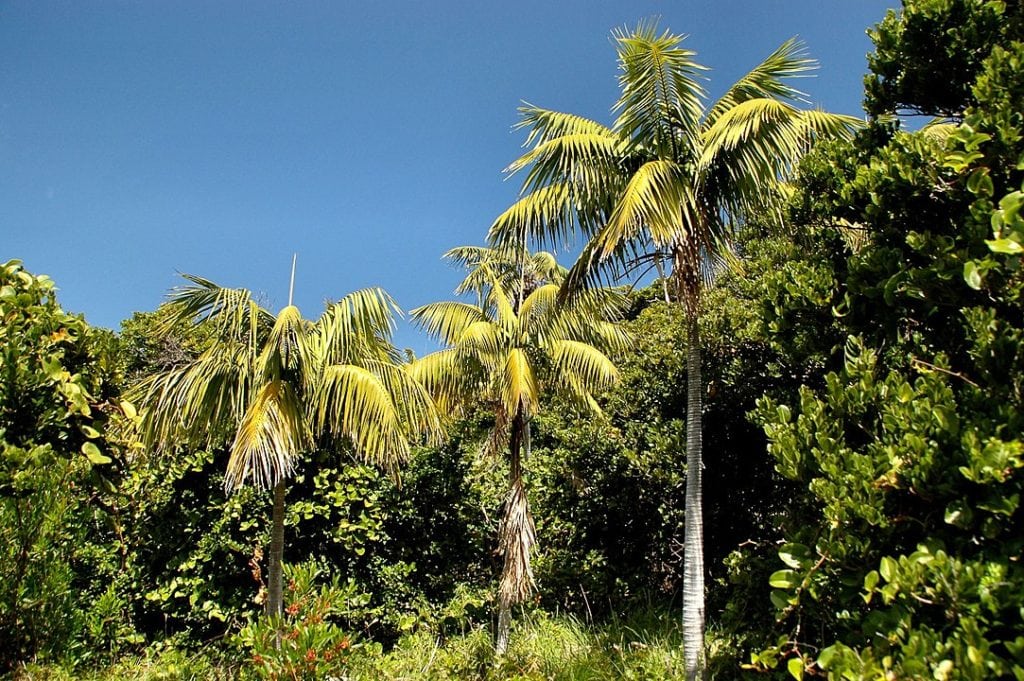
The Kentia Palm is native to Australia and is a beautiful palm tree. It looks more like a houseplant than a tree, despite how large it grows. It has several long, skinny trunks that grow from the base, but the trunks are just as green as the leaves.
The leaves are a dark green and the “fingers” of the leaves are almost oval shaped in some parts. For the most part, though, the leaflets are wide, but pointy and sprawl out from the base of the leaves.
These trees are also quite hardy, and the way the tree grows will depend on the amount of light it gets. It can tolerate very low light, but it will not grow as well. Overall, the tree can grow up to 7 feet (2.1 meters) in height. In low light, only 4-6 fronds may be produced. If it grows in medium light though, it can produce 8-12 total fronds.
38. Ponytail Palm (Beaucarnea recurvata)
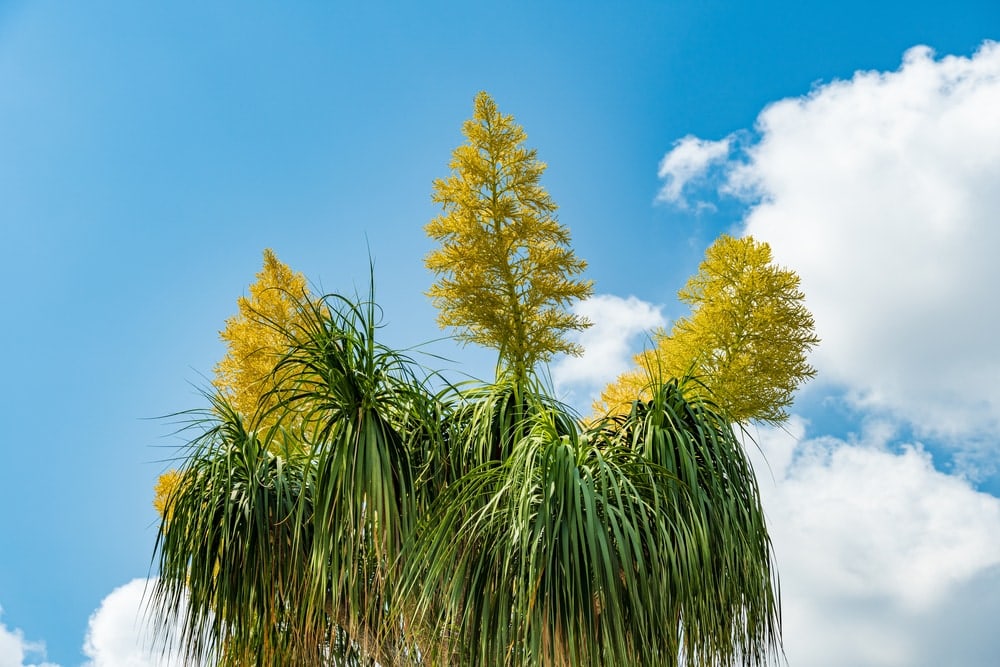
This palm tree looks quite different than most of the other palm trees on this list. It stays quite small, with a thick, bulbous trunk. The base of the trunk is thick and round like a bulb. As the trunk reaches upwards, it loses its roundness and becomes skinnier.
The leaves of the Ponytail palm are unique in that they are very long and thin. They spread from the top of the tree trunk like a head of unruly hair.
These trees can tolerate very low levels of light and they only grow to about 6 feet (1.8 meters).
39. Sago Palm (Cycas revoluta)
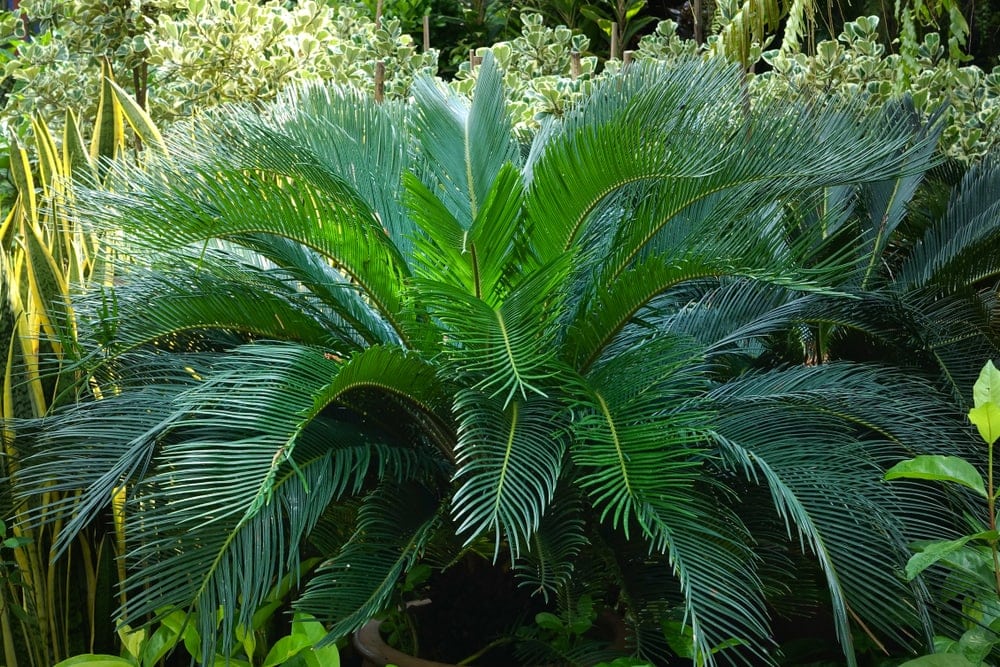
The Sago Palm tree is also quite small, only reaching about 5-7 feet (1.5 – 2.1 meters) in height. This tree also has a thick, bulbous trunk, but it does not taper off at the top. The trunk is also covered in thick, spiky bark that reaches toward the sky. The leaves of this tree are dark green and thick, spreading out over the trunk in waves.
This plant is not technically a palm tree, but is a close relative: a cycad. We’ve included it in this list because it looks very similar to the true palms.
It is very hardy and can withstand a lot of harsh environments. It is slow growing, taking up to 70-100 years to reach its full height. It can also live in colder environments.








